Juicy, fruity tomatoes are the star of this Japanese Tomato Curry with tender pieces of beef and pork simmered in a rich, savory sauce. Served over Japanese steamed rice, it‘s a hearty stew that makes a perfect weekend lunch or dinner! {Vegetarian options included}
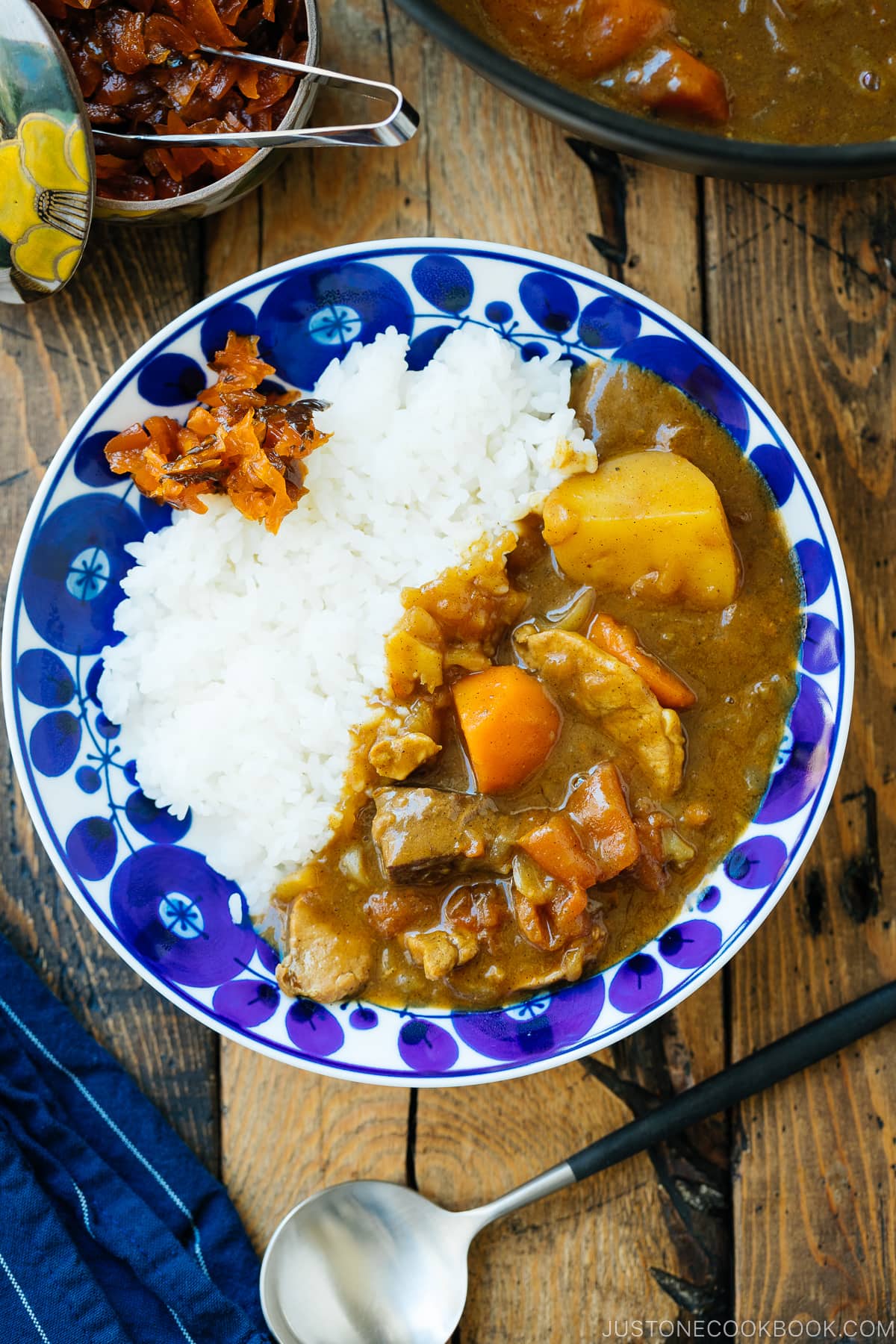
Japanese curries are a staple in my household so I’m always open for new and tasty versions to add to my curry repertoire. After watching The Makanai: Cooking for the Maiko House on Netflix, I was inspired to make Japanese Tomato Curry (トマトカレー).
The curry-making scenes in the drama are only a brief second but with a little imagination you could almost smell the fragrance wafting from the pot. I was left hungry and determined to recreate the curry at home so we could all enjoy it.
If you landed on this page looking for the Tomato Curry recipe featured in the drama, don’t forget to check this post and try other recipes from The Makanai!
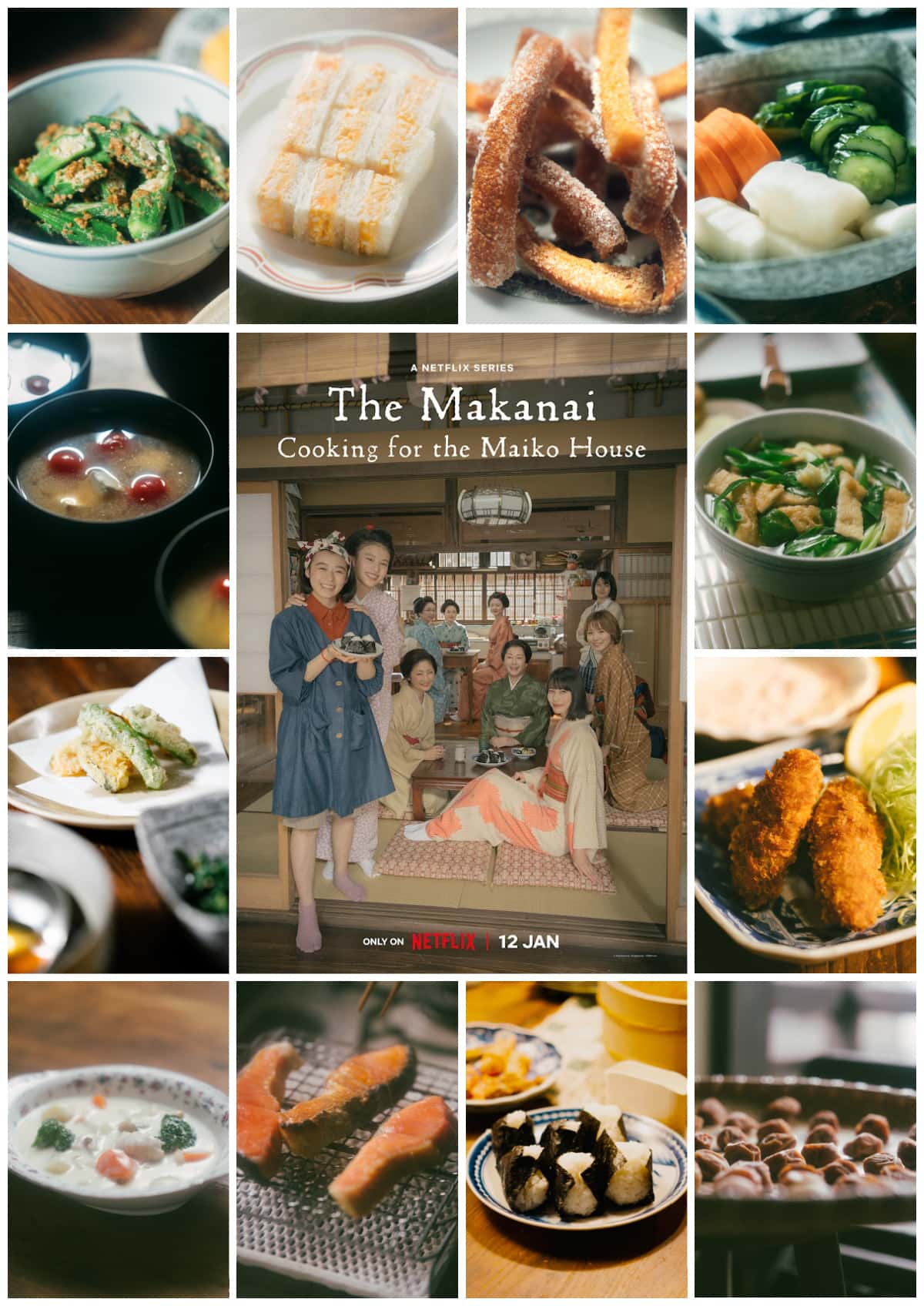
Table of Contents
What is Japanese Curry?
Japanese curry is quite different from most other curries in the world. It has a thicker consistency and the taste leans on the sweet and savory side, not necessarily spicy.
The common ingredients include one or a mixture of protein and root vegetables like sweet onions, carrots, and potatoes. The sauce is thickened by a roux (a mixture of fat and flour) and layered with spices and earthy flavors. Compared to Thai or Indian curry, Japanese curry might remind you of a hearty stew.
If you wish to train your kids to appreciate spiced-flavored food, I’d say start with Japanese curry! It has a milder heat so it’s suitable for their palate. This tomato curry would have even more appeal to children because of the familiar tangy flavor.
Don’t miss my Japanese curry recipes roundup, which includes vegetarian curry and more!
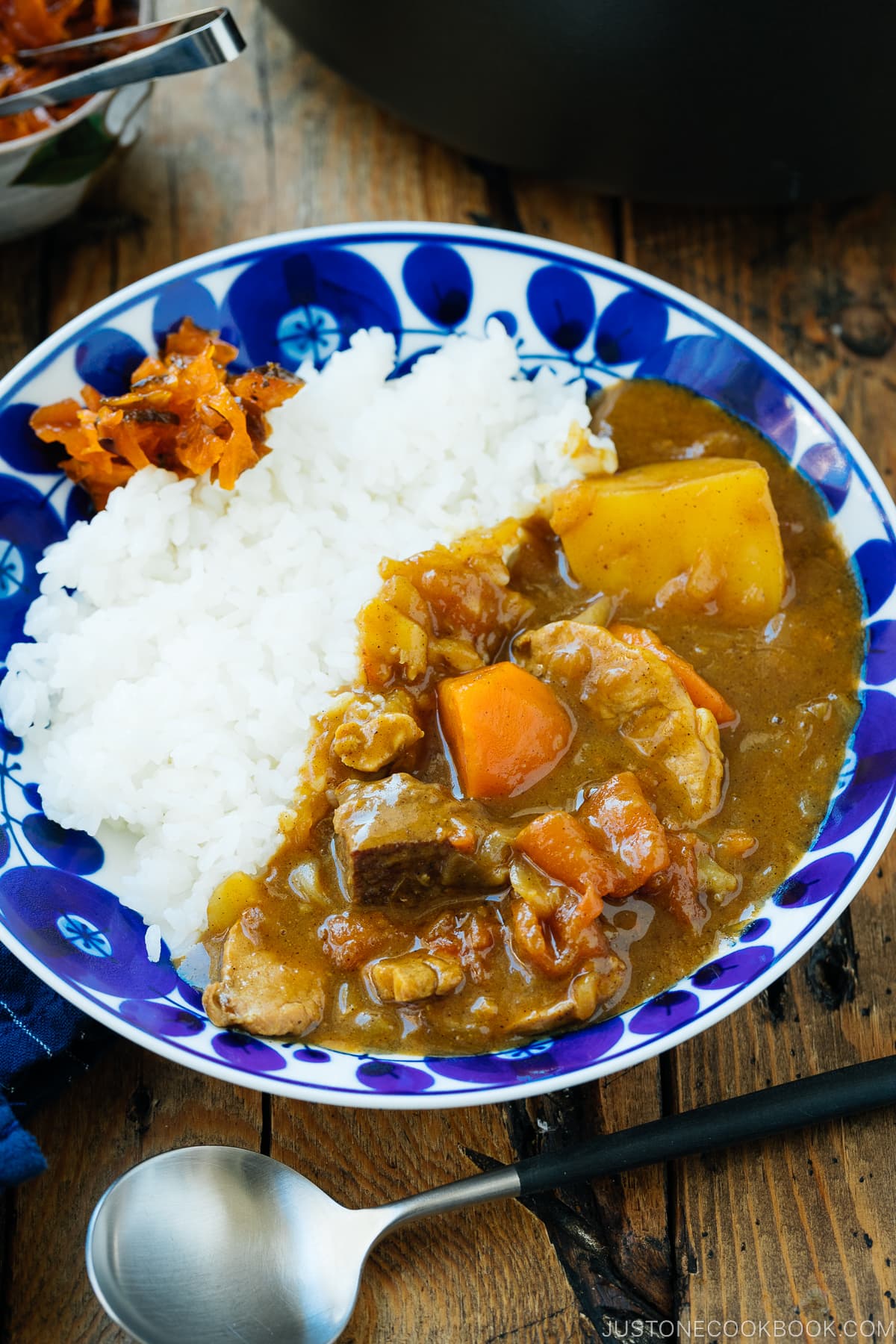
How to Make Japanese Tomato Curry
Ingredients You’ll Need
- Beef chuck roast – Stew beef is slightly more economical but not as tender after cooking.
- Pork tenderloin
- Onions
- Carrots
- Russet potatoes – You can also use Yukon gold potatoes.
- Tomatoes – Use round and firm tomatoes that are fruity, juicy, and full of flavor; vine-ripened, heirloom varieties work particularly well; avoid beefsteak tomatoes that have a milder flavor.
- Ginger
- Garlic
- Beef stock/broth
- Japanese curry roux – If you can’t find it, make my Homemade Curry Roux
- Other seasonings: Salt, freshly ground black pepper, oil, butter, and soy sauce
- Japanese short-grain rice – You can cook it with a rice cooker, pot over the stove, Instant Pot, or donabe.
Ingredient Substitutions
Do we need to use both beef and pork? No, you don’t have to. Kiyo in the drama makes her grandma’s tomato curry, which includes both beef and pork.
How can I make this vegetarian friendly? Skip beef and pork and use king oyster mushrooms or eggplant instead (they have a nice meat-like bite). Use vegetable broth or simply use tomato blanching water.
Overview: Cooking Steps
- Blanch tomatoes in boiling water to peel their skin off.
- Cut all the ingredients.
- Sear the meat and take them out.
- Cook the onions until they are translucent and golden. Then, add the tomatoes, carrots, and beef broth and let it simmer for 45 minutes. Lastly, add the potatoes and cook for 15 minutes.
- Add the curry roux and simmer for 5 minutes. Serve hot with steamed rice.
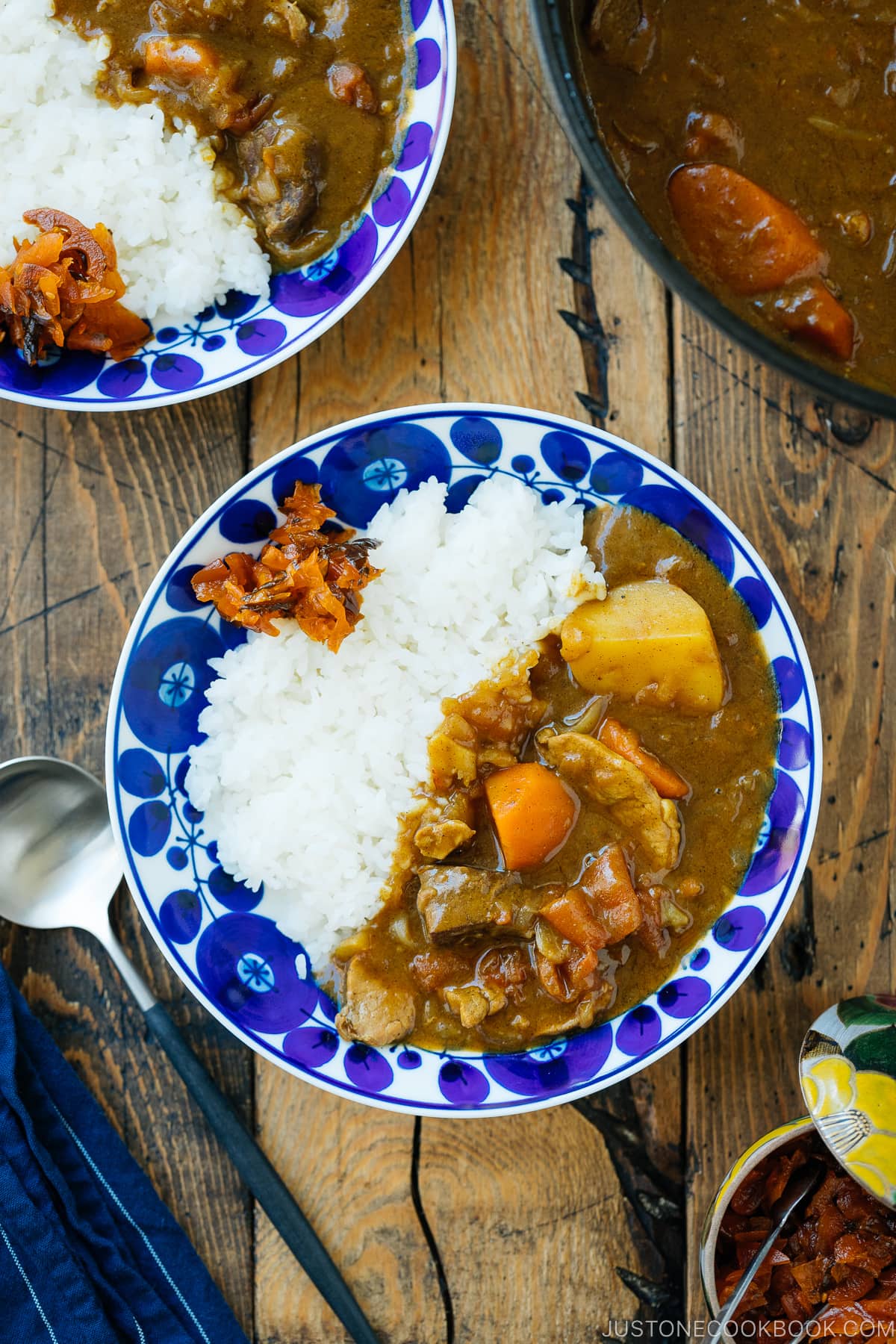
Why Do We Remove the Tomato Skin?
The tomato skin remains even if it is cooked for a long time. When you eat the food and the tomato skin is left in the mouth, some people believe that it ruins the flavor and texture of the dish. Personally, I recommend removing the firm skin to improve the texture of the curry.
That said, if you don’t mind the texture of the tomato skin, you don’t have to peel it.
5 Steps to Peel a Tomato
The easiest way to remove the tomato skin is to blanch the tomatoes in boiling water. This is the most common and efficient way to peel the tomato.
Step 1: Remove the stem end
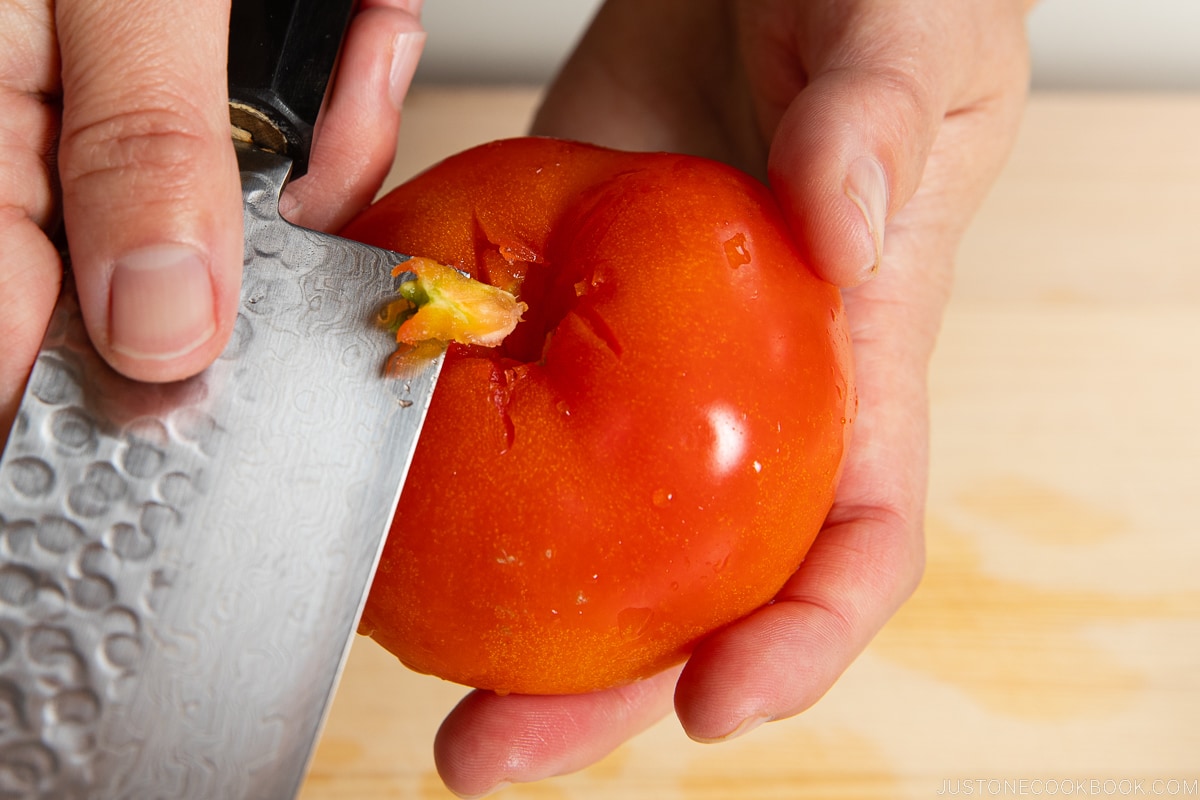
Insert the tip of a very sharp knife (like a paring knife) at the stem end, about ½ inch (1.25 cm) deep. Angle the knife and cut around the stem end in a circular motion to remove the hard core.
Step 2: Score the skin on the bottom of the tomato with an “X”
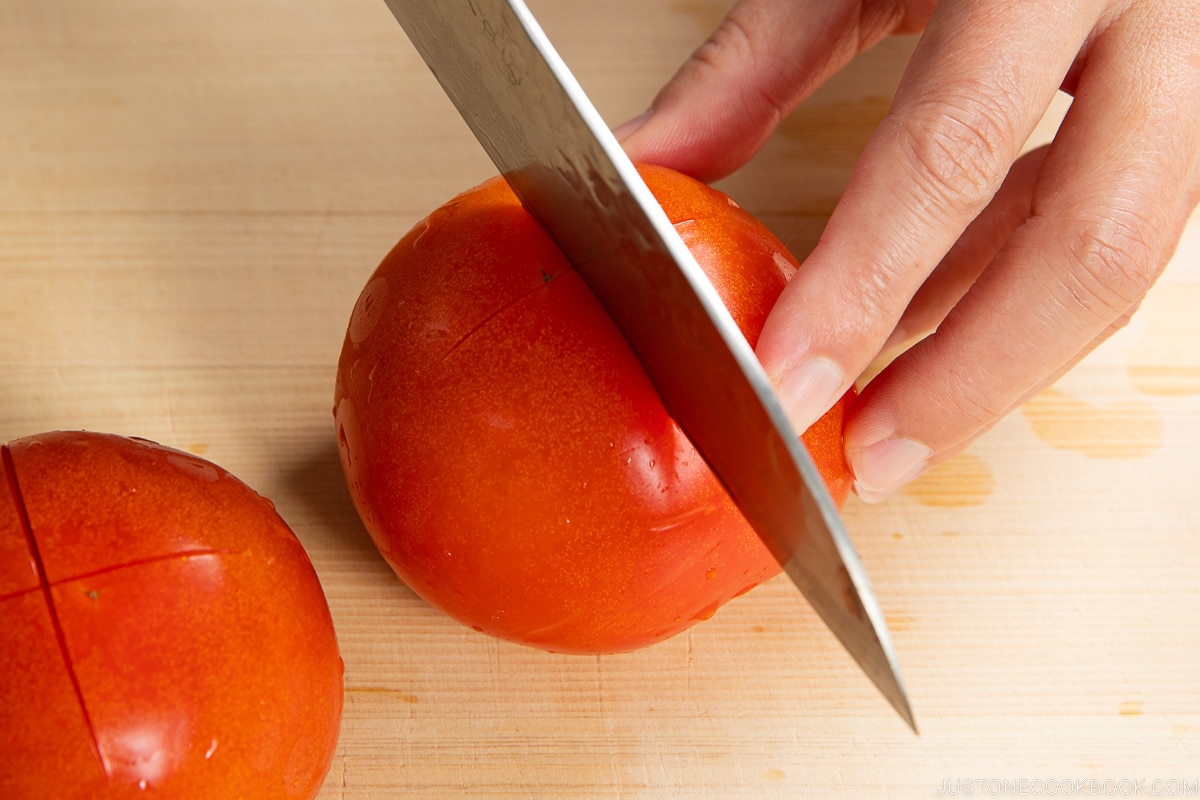
Next, lightly score the skin on the bottom of the tomato with an “X” about 2 inches (5 cm) long. Repeat with the rest of the tomatoes.
Step 3: Blanch the tomatoes
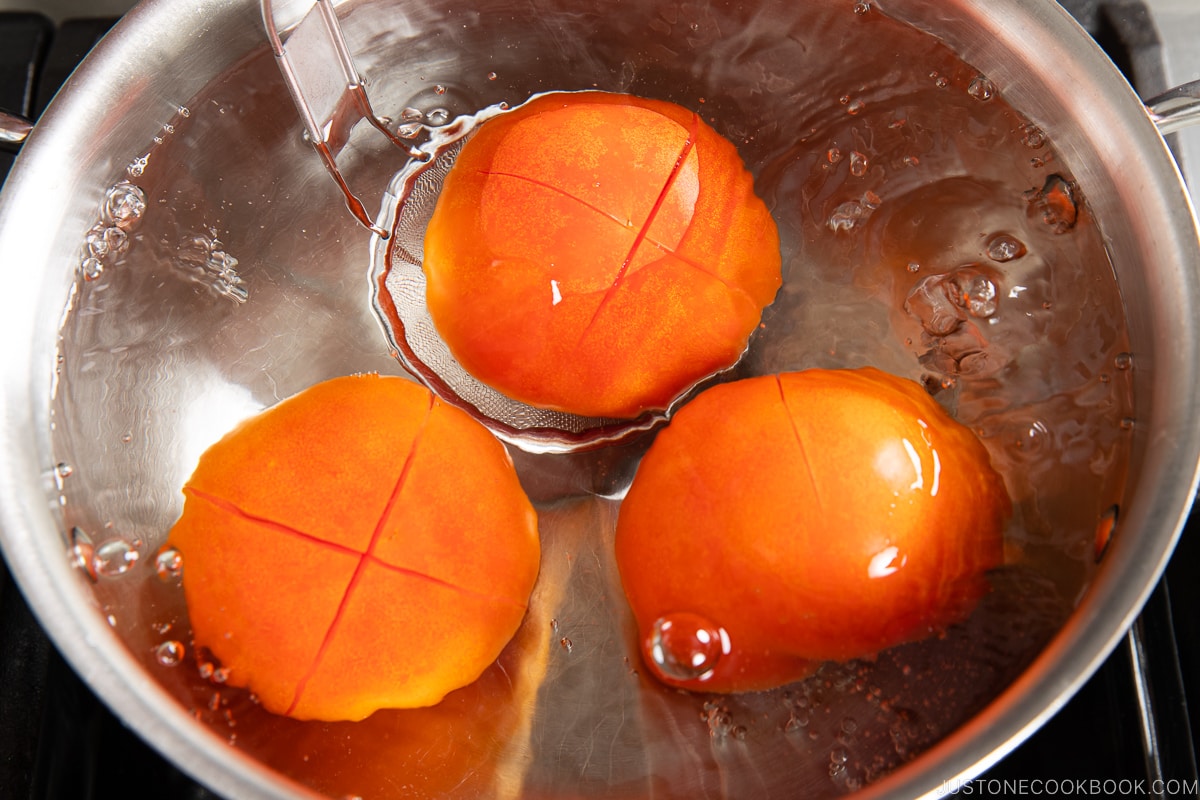
Gently place the tomatoes in the boiling water. Make sure there is enough water to completely submerge the tomatoes. Blanch for 15 seconds or until you see the tomato skins start to peel back. You don’t have to wait until all the skin is completely peeled. Larger tomatoes may require more time, but don’t overcook them because the flesh will become mushy. Please RESERVE this tomato blanching water for later use!
Step 4: Transfer to an ice bath
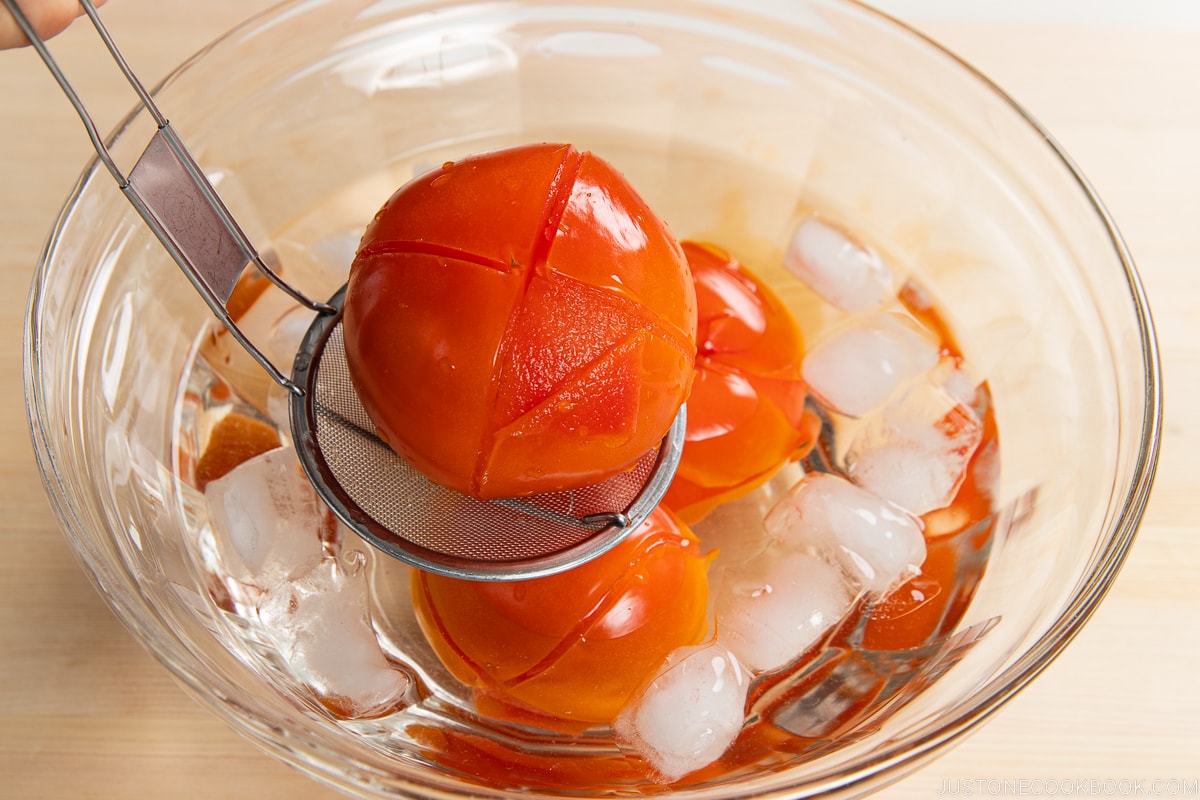
Using a fine-mesh skimmer or slotted spoon, remove the tomatoes and immediately transfer them to a bowl filled with ice water to quickly cool down and stop cooking.
Step 5: Peel the tomato skin
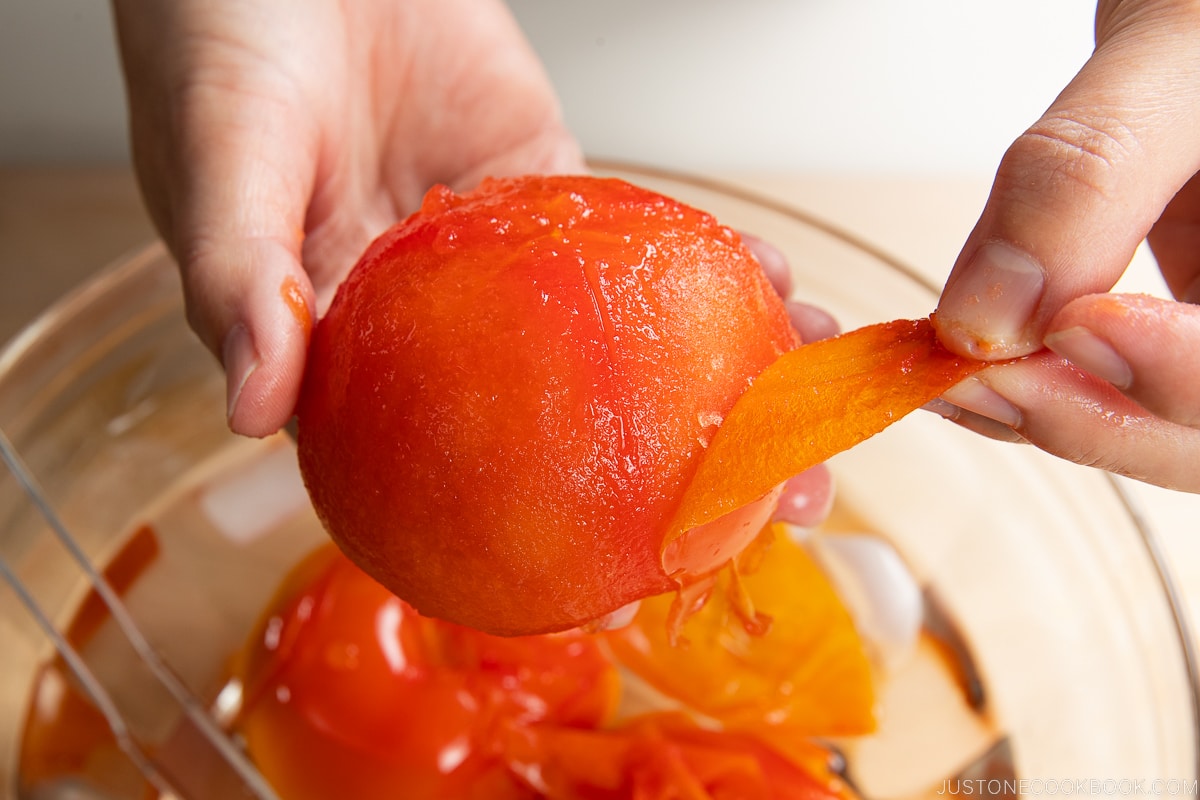
When the tomatoes are cool enough to handle, peel and discard the tomato skins using the knife or your fingers. Now they are ready to use!
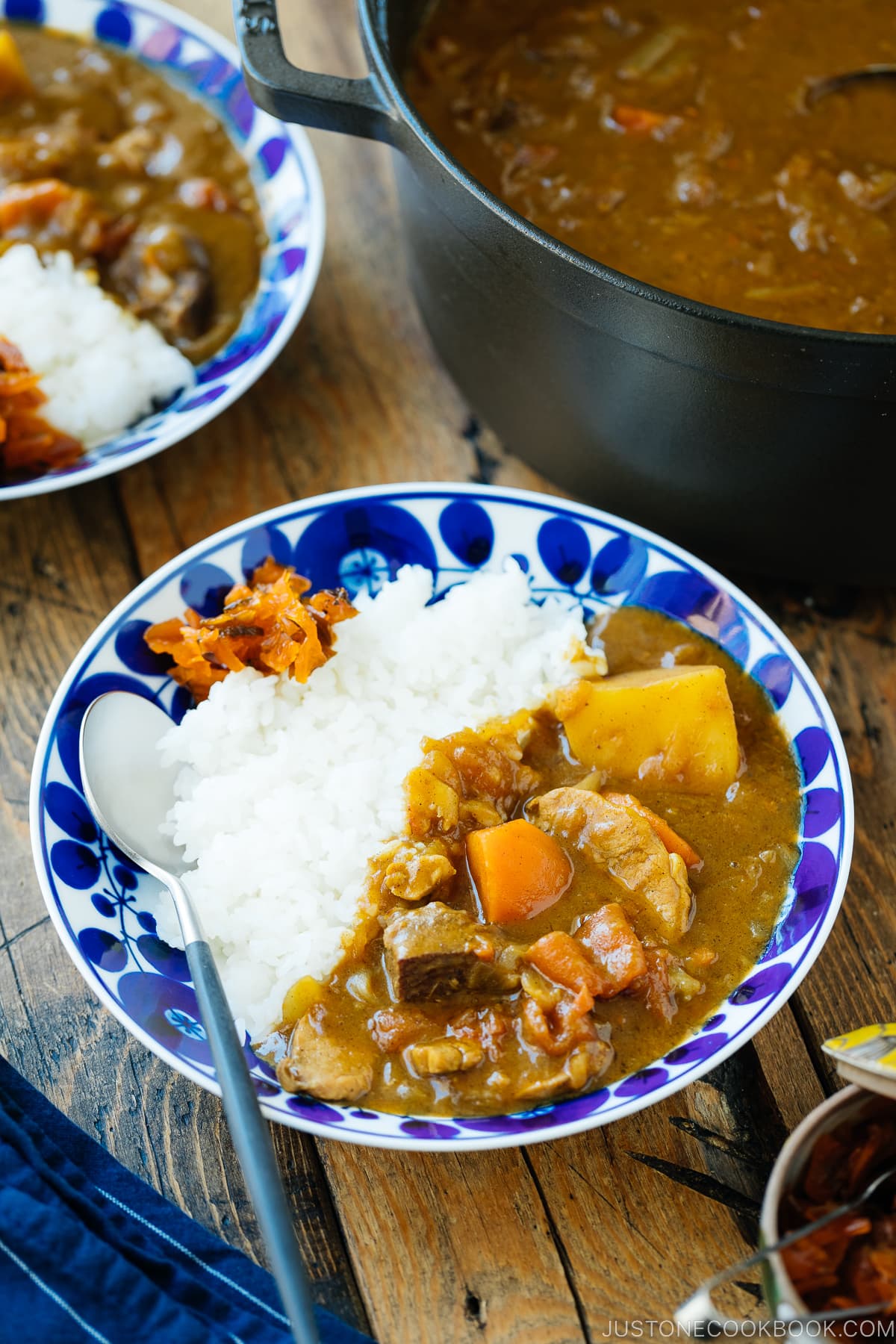
Tomato Curry Cooking Tips
- Use beef chuck roast. Butcher counters sell pre-cut stew beef. This cut is more economical because it’s made up of the odds and ends from other different cuts. Chuck roast, on the other hand, is from the shoulder muscles, and while initially quite tough, cubes of chuck roast can break down into tender, succulent, flavorful meat after cooking low and slow. If you can’t get chuck roast, try round roast, rump roast, or pot roast.
- Sear the meat well. This is an essential step if you want to make the most flavorful meat. Searing caramelizes the natural sugars in the meat and browns the proteins, forming a bronze crust on the surface that amplifies the savory flavor of the finished dish. You will be rewarded with a delicious curry with tender pieces of meat in a rich, velvety sauce.
- Caramelize the onion. When you slow cook the onions over an extended period of time, the natural sugar in the onions caramelizes, bringing out their sweetness and making them extremely flavorful. It takes time, but you can always get the other prep work done while sautéing the onions.
- Personalize the curry. The beauty of curry is its room for customization. Every cook has the freedom to enhance and personalize the flavors with different ingredients (some can be unexpected). You can see the full list in my Japanese Chicken Curry recipe. For this tomato curry, I wanted to keep it simple and bring the tomato flavor. So, I used garlic, ginger, and soy sauce. Try out different combinations or change up the proportions to see what you like.
- Add the Russet potatoes later. If you’re using Russet potatoes, they tend to disintegrate into the broth during cooking. So add them 15 minutes before the total cooking time. If you use Yukon gold potatoes, they hold their shape so you can add them to the pot along with carrots.
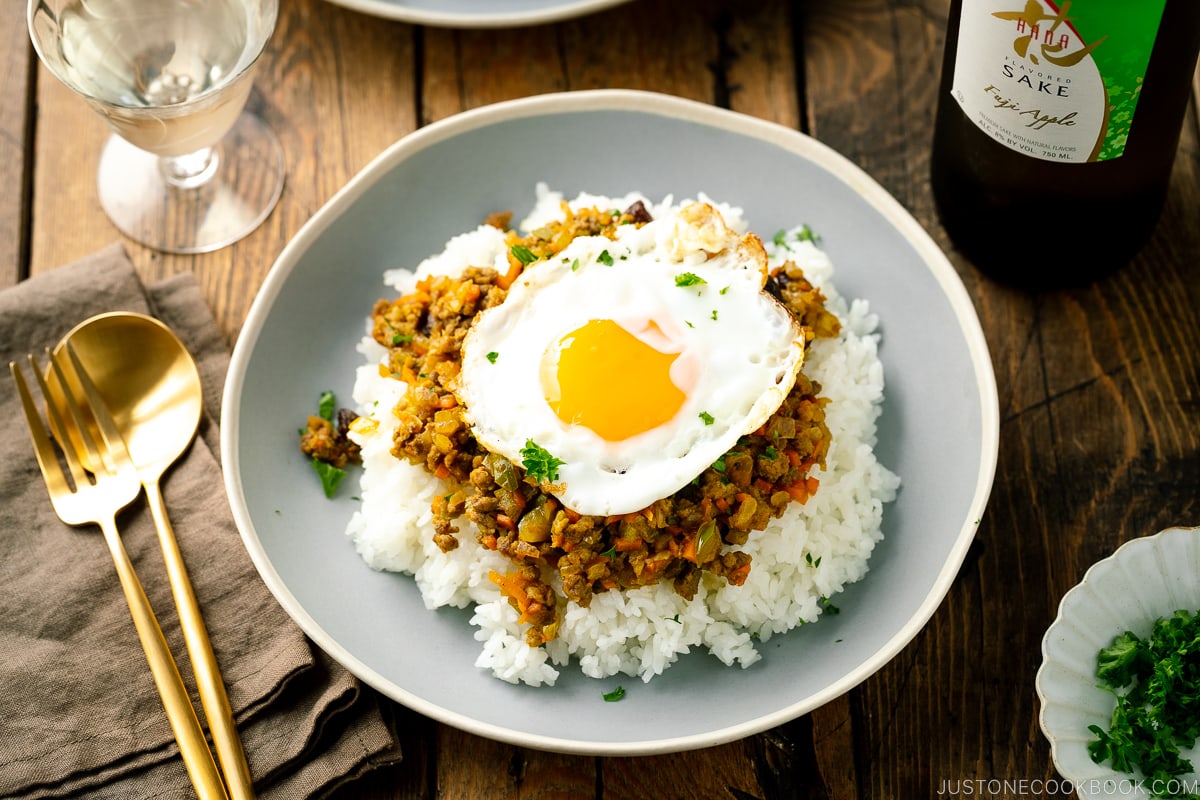
Other Popular Curry Recipes
- Japanese Dry Curry
- Japanese Beef Curry
- Japanese Chicken Curry
- Sapporo Soup Curry
- Curry Doria
- Curry Udon
- Keema Curry
- Curry Bread
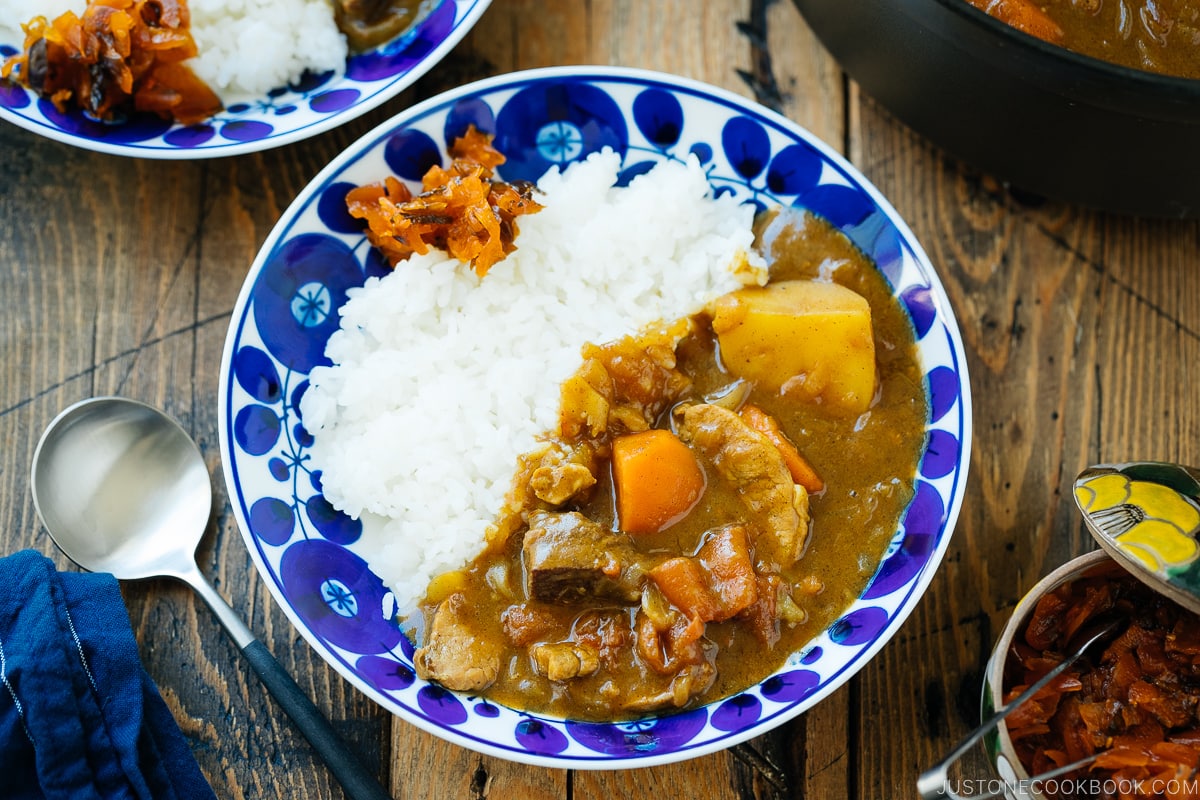
Wish to learn more about Japanese cooking? Sign up for our free newsletter to receive cooking tips & recipe updates! And stay in touch with me on Facebook, Pinterest, YouTube, and Instagram.

Japanese Tomato Curry
Video
Ingredients
- 3 tomatoes (1 lb, 454 g; use round and firm tomatoes that are juicy, fruity, and full of flavor; vine-ripened and heirloom varieties work well; avoid beefsteak tomatoes for their mild flavor)
- 3 russet potatoes (¾ lb, 340 g; you can also use Yukon gold potatoes)
- 3 onions (1 lb, 454 g)
- 2 carrots (½ lb, 227 g)
- 2 cloves garlic
- 1 tsp ginger (grated, with juice; from a 1-inch, 2.5-cm knob)
- 1 lb boneless beef chuck roast (stew beef is slightly more economical but not as tender; for vegetarian, substitute king oyster mushrooms and/or eggplants)
- ½ lb pork tenderloin (use king oyster mushrooms and/or eggplants for vegetarian)
- ½ tsp Diamond Crystal kosher salt
- ¼ tsp freshly ground black pepper
For Cooking the Curry
- 2 Tbsp neutral oil (divided for the beef and onions)
- 2 cups beef stock/broth (½ QT; store-bought beef stock is often salted; for less sodium intake, use 1 cup/240 ml beef stock + 1 cup/240 ml tomato blanching water; for vegetarian, use vegetable stock or reserved tomato blanching water)
- 2 cups reserved tomato blanching water (plus more to dilute the curry sauce, as needed)
- 1 Tbsp soy sauce
- 1 box Japanese curry roux (7–8.4 oz, 200–240 g store-bought sauce mix; or make your own with my homemade Japanese Curry Roux recipe)
- Diamond Crystal kosher salt (optional; add only if using my homemade Japanese Curry Roux recipe, which is unsalted)
For Serving
- fukujinzuke (Japanese red pickled vegetables) (optional; you can make my Homemade Fukujinzuke recipe)
Instructions
- Gather all the ingredients.
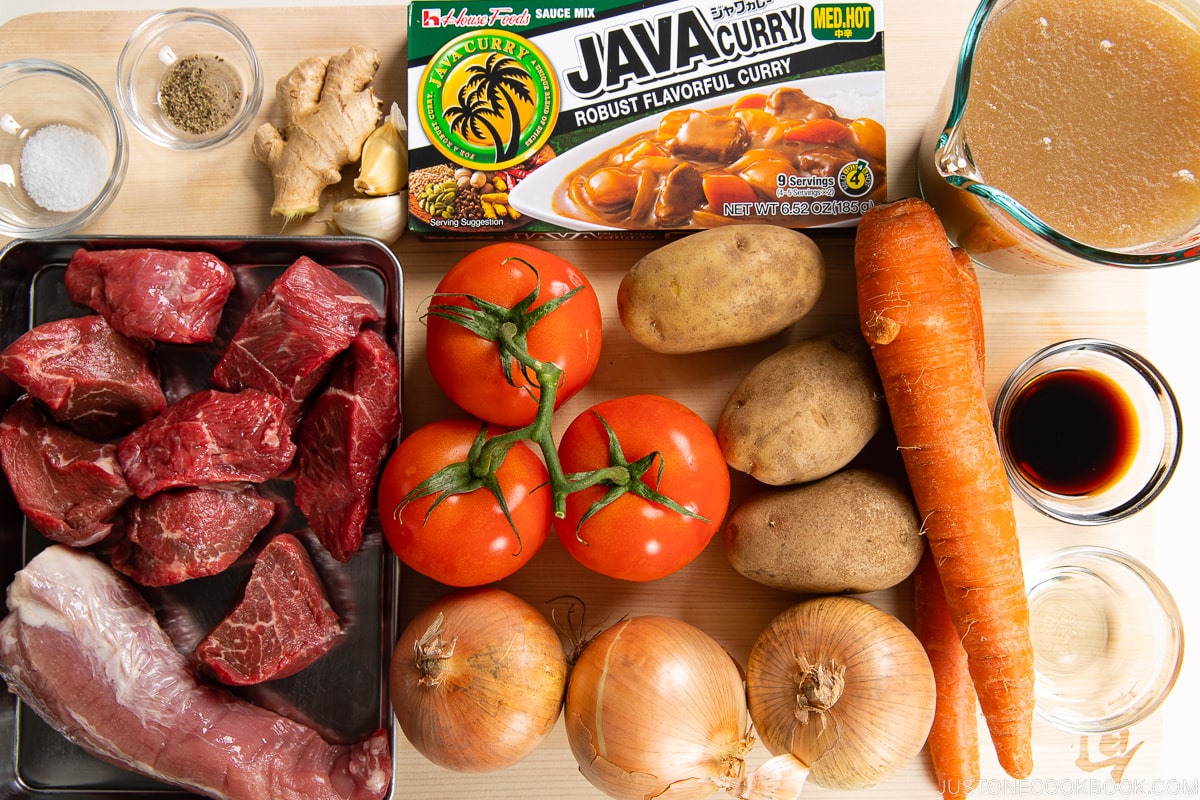
To Peel the Tomatoes
- Prepare a medium pot of water and bring it to a boil. Now, core 3 tomatoes. Insert the tip of a very sharp knife (like a paring knife) at the stem end, about ½ inch (1.25 cm) deep. Angle the knife and cut around the stem end in a circular motion to remove the hard core. Next, lightly score the skin on the bottom of the tomato with an “X“ about 2 inches (5 cm) long. Repeat with the rest of the tomatoes.
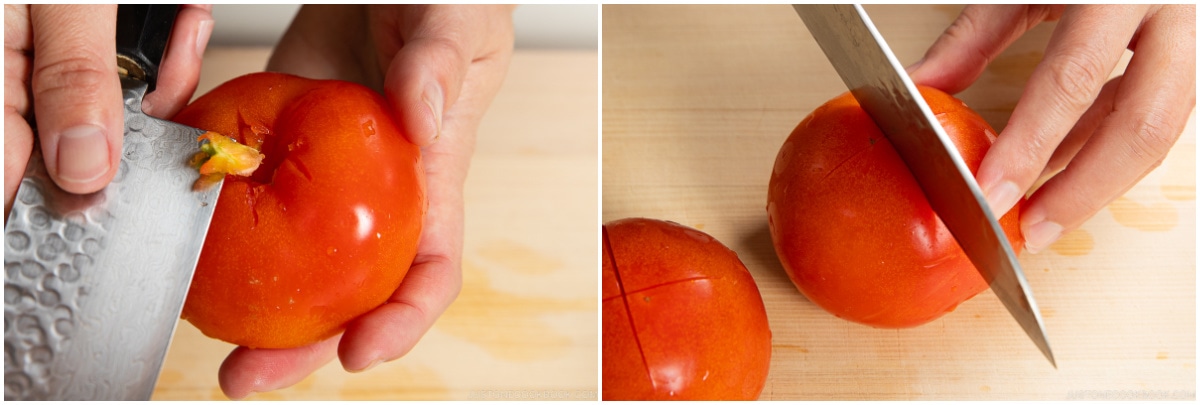
- Gently place the tomatoes in the boiling water. Make sure there is enough water to completely submerge the tomatoes. Blanch for 15 seconds or until you see the tomato skins start to peel back. You don’t have to wait until all the skin is completely peeled. Larger tomatoes may require more time, but don’t overcook them because the flesh will become mushy.
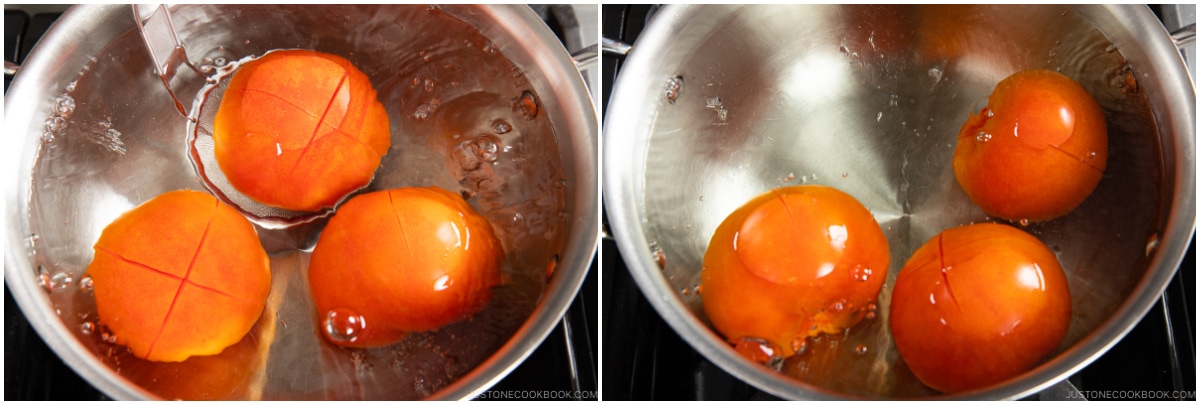
- Using a fine-mesh skimmer or slotted spoon, remove the tomatoes and immediately transfer them to a bowl filled with ice water to quickly cool down and stop cooking.
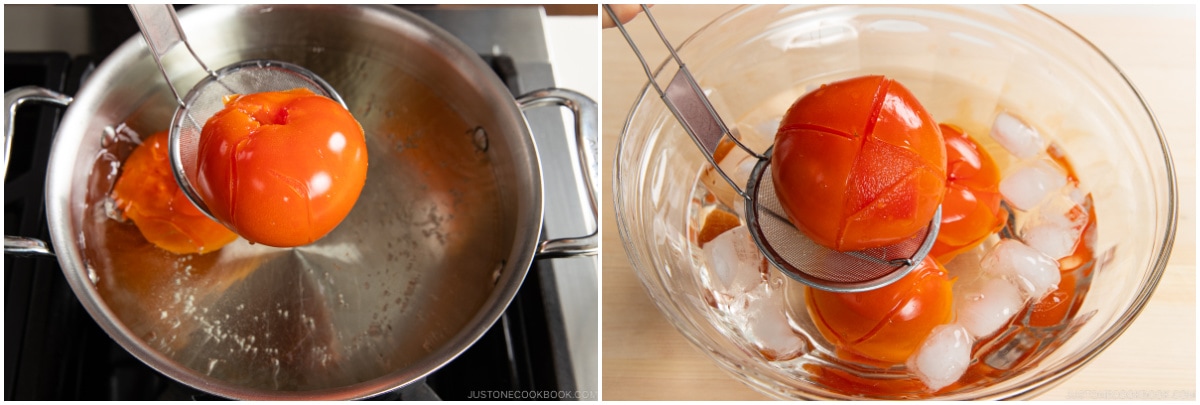
- For this Japanese Tomato Curry recipe, RESERVE this tomato blanching water! We will use it later. When the tomatoes are cool enough to handle, peel and discard the tomato skins using the knife or your fingers.
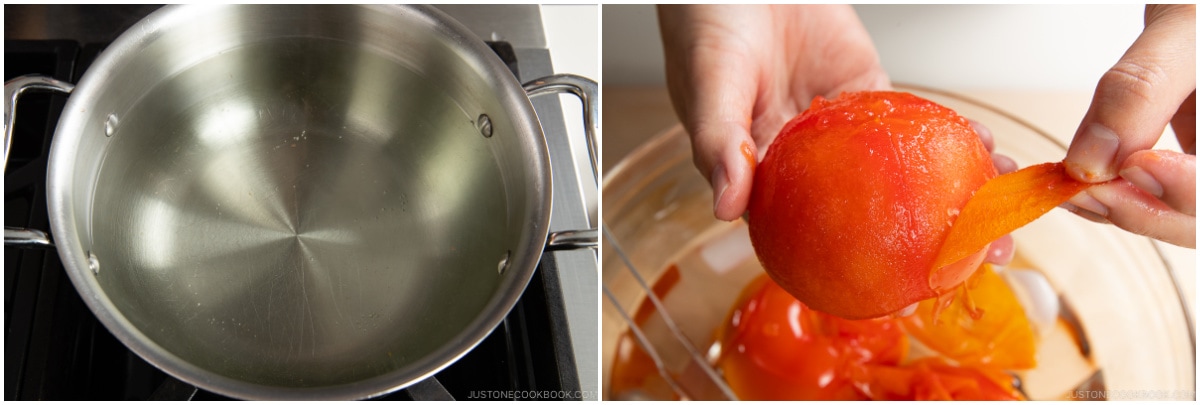
- Cut each tomato into 8 wedges. Set aside.
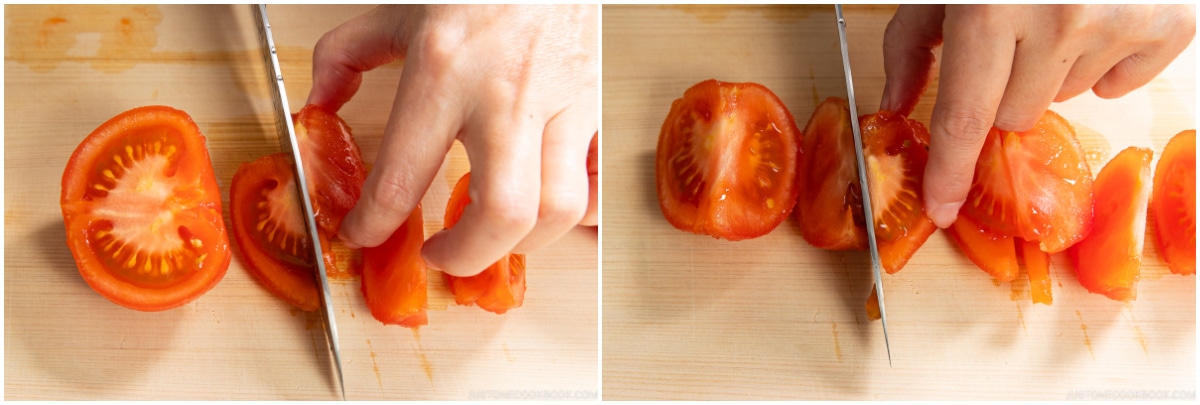
To Prepare the Other Ingredients
- Peel 3 russet potatoes and remove the eyes.
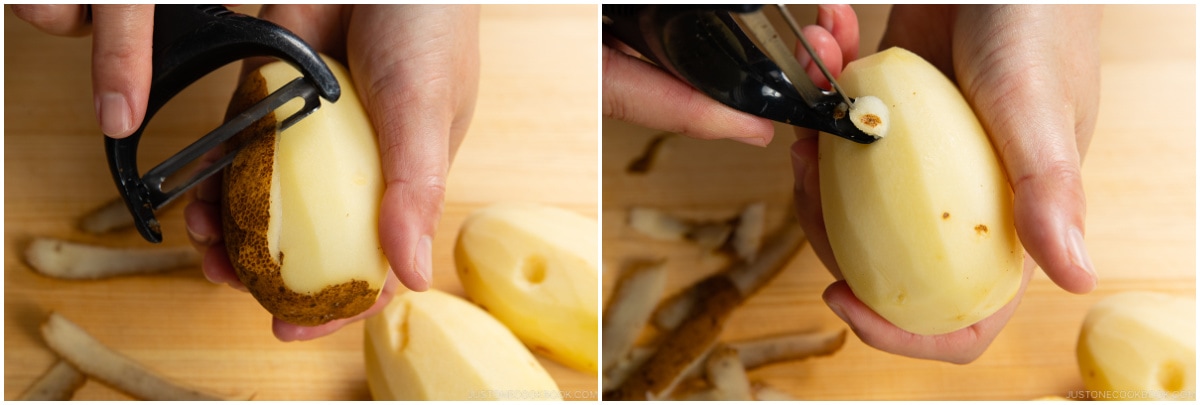
- Cut the potatoes into 1½-inch (3.8-cm) pieces. Soak the pieces in water for 15 minutes (or until added to the pot later on) to remove the starch. Drain and set aside. Tip: My russet potatoes are on the small side, so I cut them into quarters. For typical russet potatoes, cut them into thirds, then cut each piece in half or quarters.
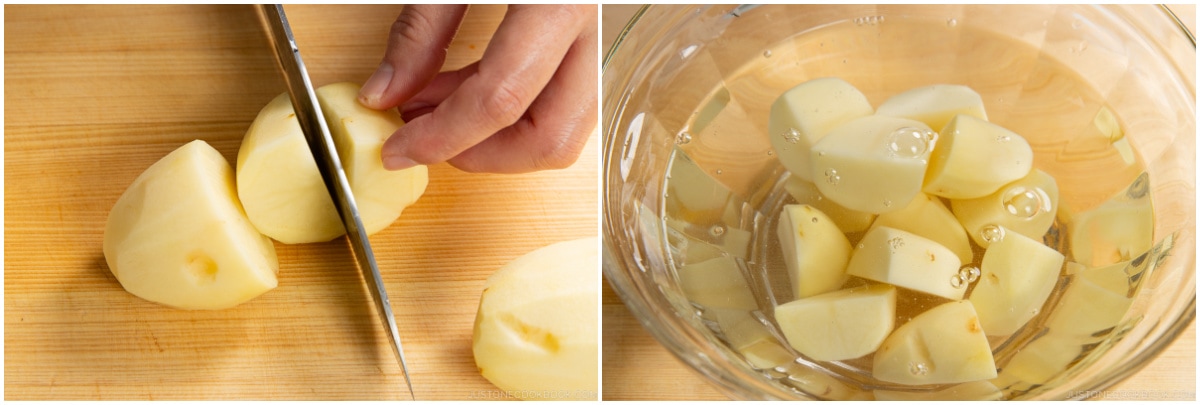
- Cut 3 onions in half lengthwise. Then, cut each half into thin lengthwise slices.
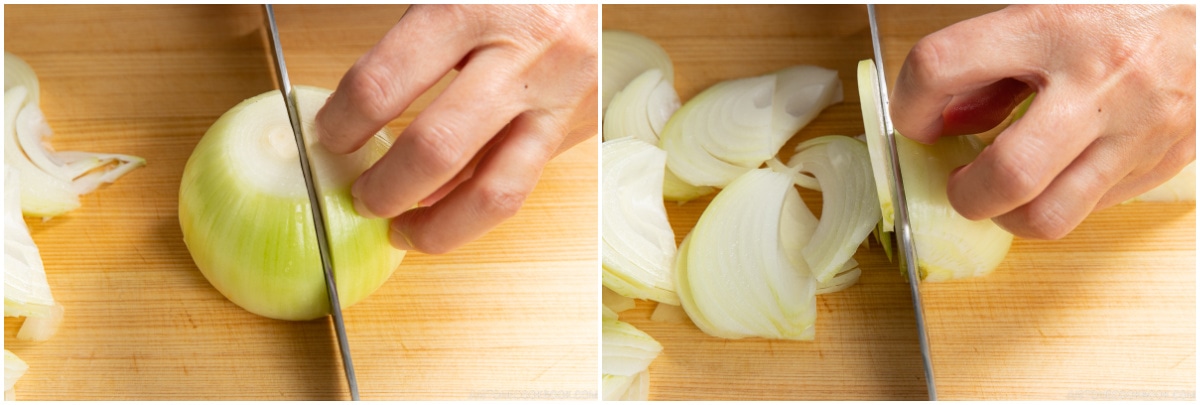
- Peel 2 carrots and cut them diagonally while rotating a quarter turn between cuts (we call this cutting technique rangiri in Japanese).
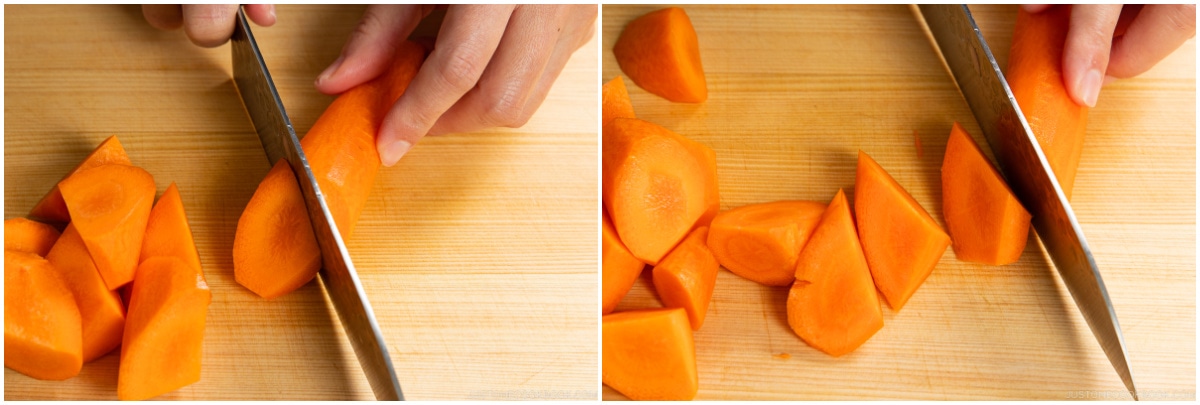
- Peel 2 cloves garlic and mince them (I use this garlic press). Peel and grate the ginger, measure 1 tsp ginger (grated, with juices), and set aside.
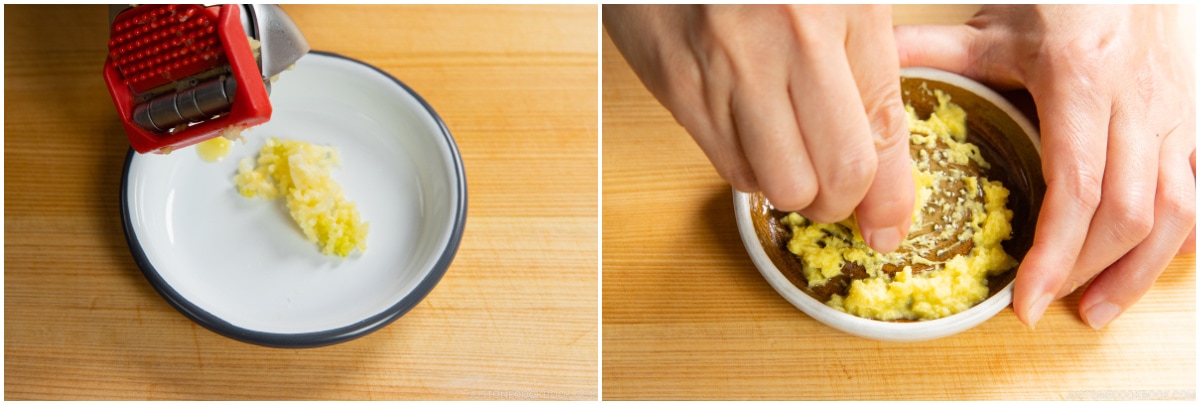
- Cut 1 lb boneless beef chuck roast into 1½-inch (3.8-cm) cubes. Next, cut ½ lb pork tenderloin into ¼-inch (6.3-mm) slices.
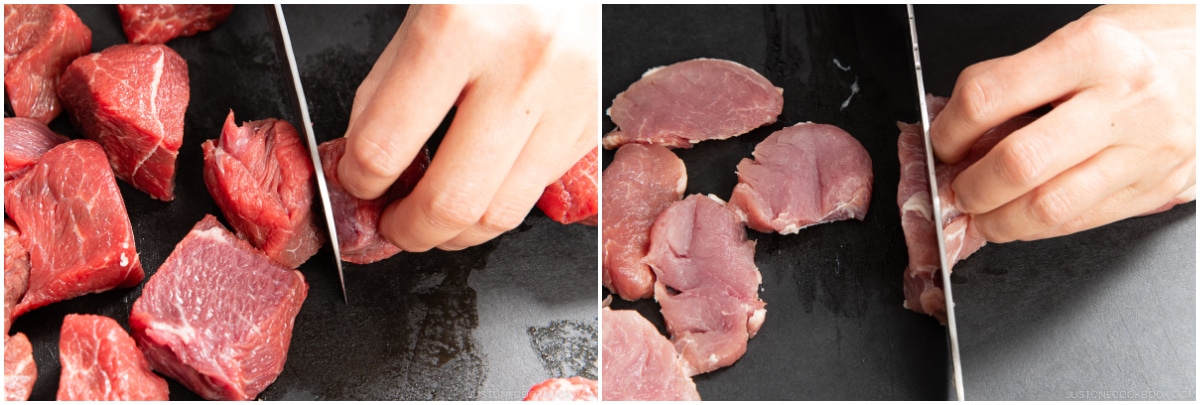
- Lightly sprinkle the beef and pork with ½ tsp Diamond Crystal kosher salt and ¼ tsp freshly ground black pepper.
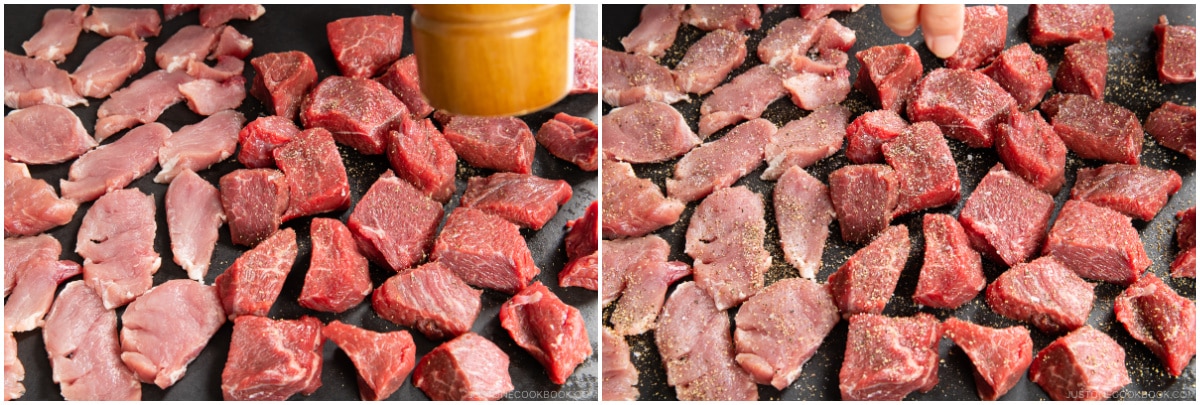
To Cook the Meat and Onions
- Preheat a large heavy-bottomed pot (I used this 5.5-QT Staub Dutch oven) on medium heat. When the pot is hot, add 1 Tbsp neutral oil. Add some of the beef cubes in a single layer, leaving plenty of space between each piece of meat. Make sure not to crowd the skillet; otherwise, the excess moisture in the pan will end up “steaming“ the meat. Cook the beef in 2–3 batches.
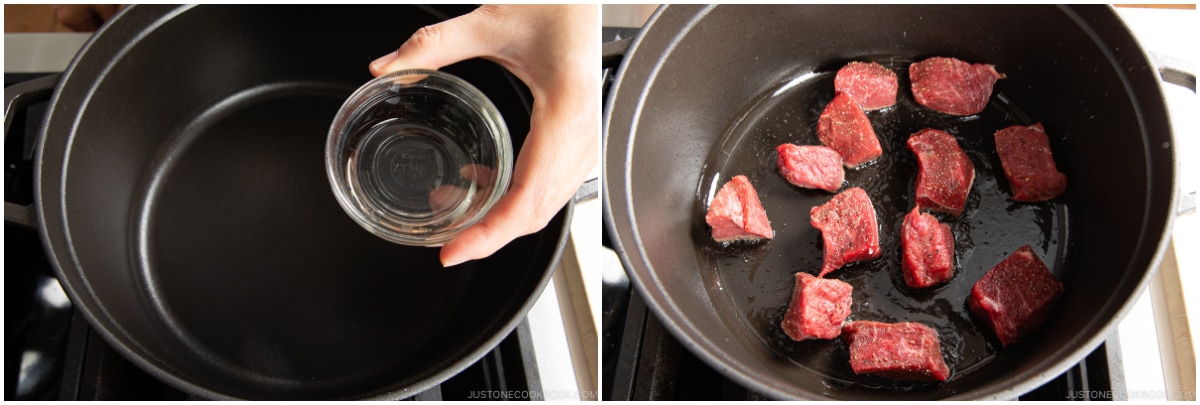
- Sear the beef cubes (do not move them) on one side until brown and crusty, about 3–4 minutes, then flip to cook the other side. The meat will release itself from the pan when the surface is seared nicely. Transfer the seared meat to a plate and work on the next batch.
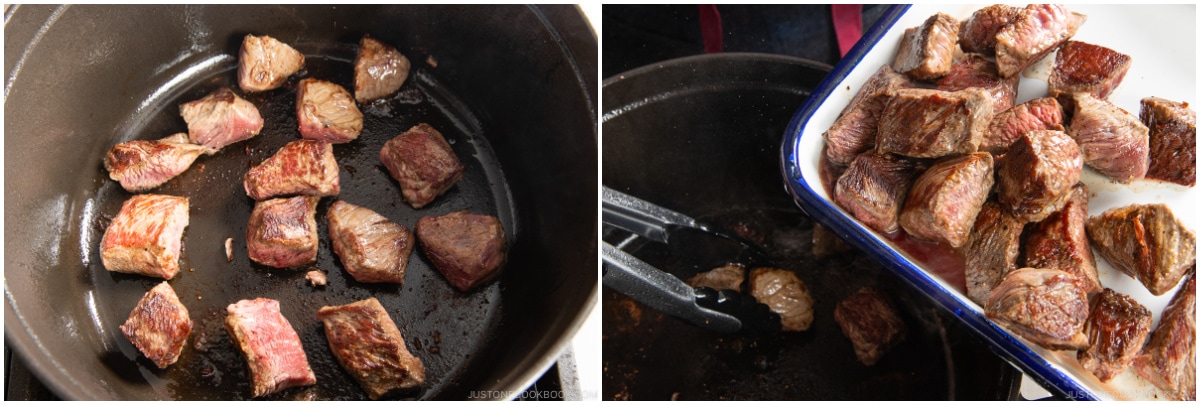
- When you finish searing all the beef, add the onions to the pot and deglaze the bottom of the pot.
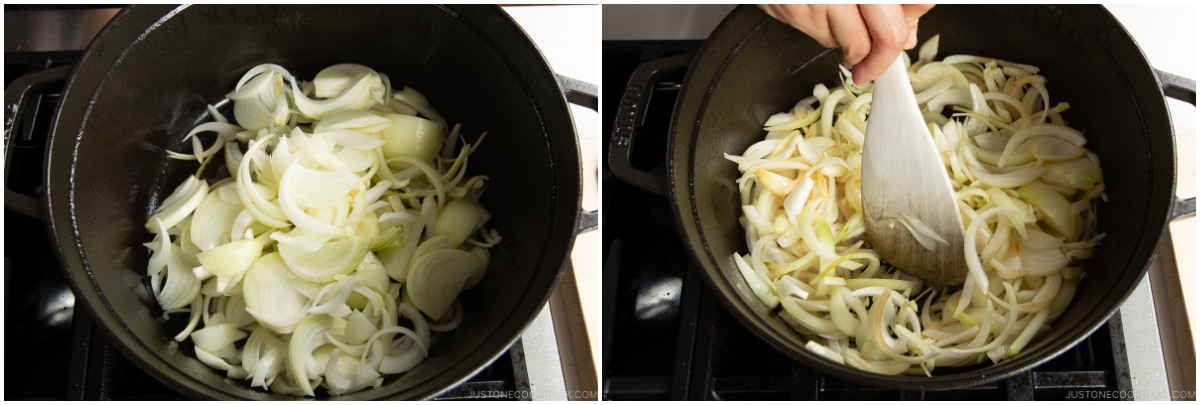
- Add the remaining 1 Tbsp neutral oil, if needed (I added ½ Tbsp of oil here). Sauté the onions, stirring once in a while, for about 6–8 minutes. When the onions are wilted, reduce the stove‘s heat to medium low (as they tend to burn quickly).
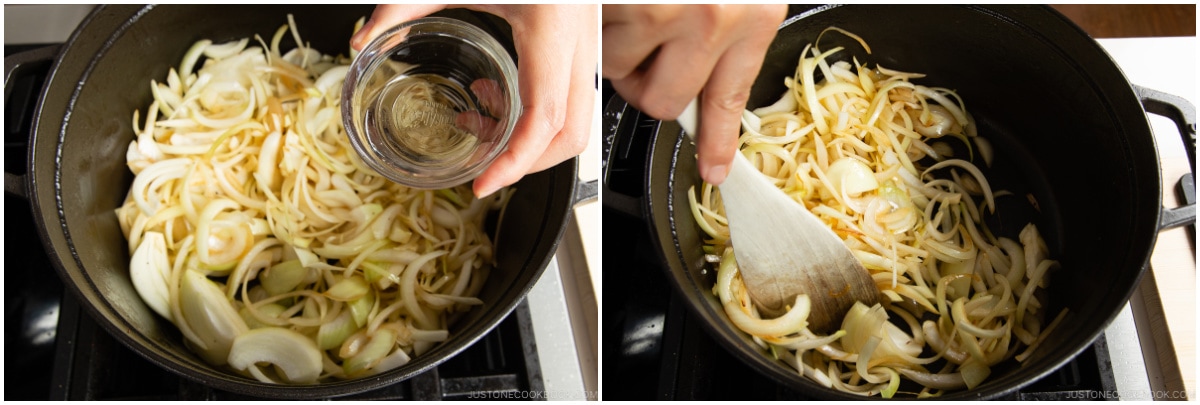
- Once the onions are tender, translucent, and a bit caramelized, add the grated ginger and minced garlic to the pot and stir to mix.
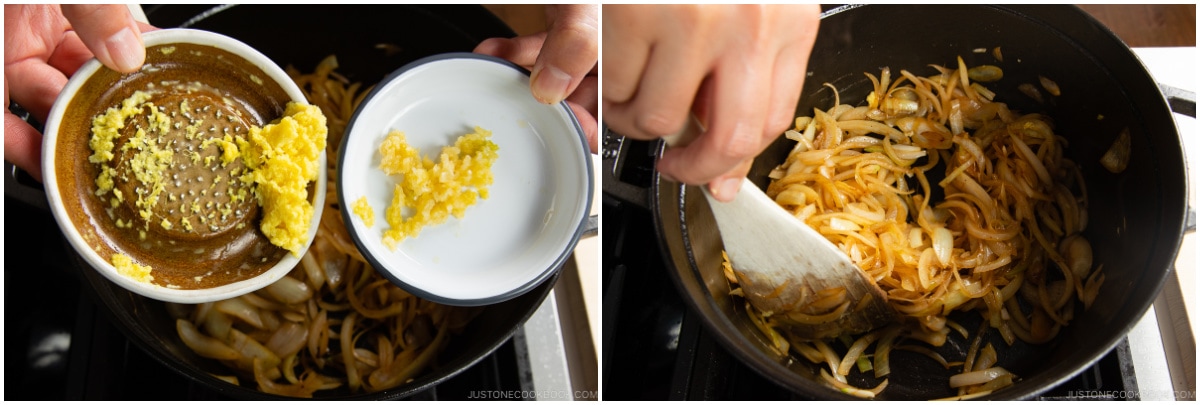
- Add the pork tenderloin, seared beef, and any juices from the plate.
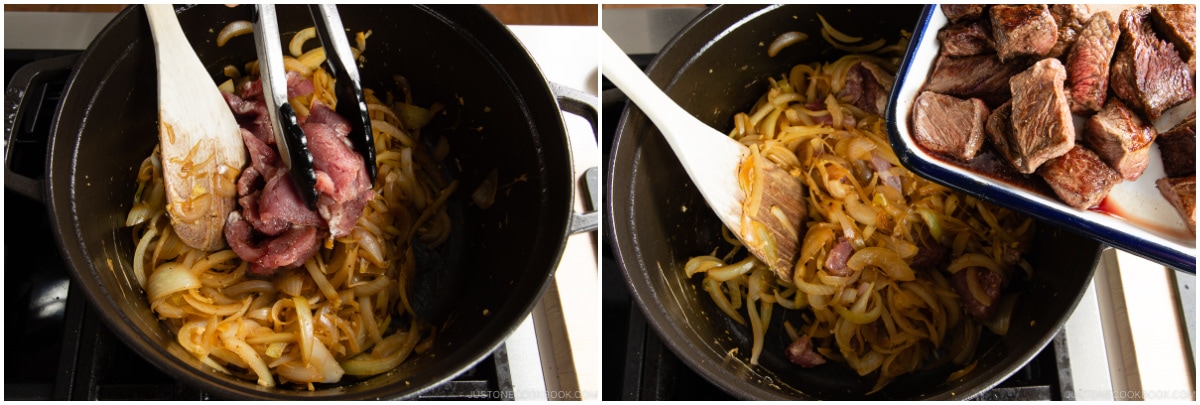
- Stir to mix.
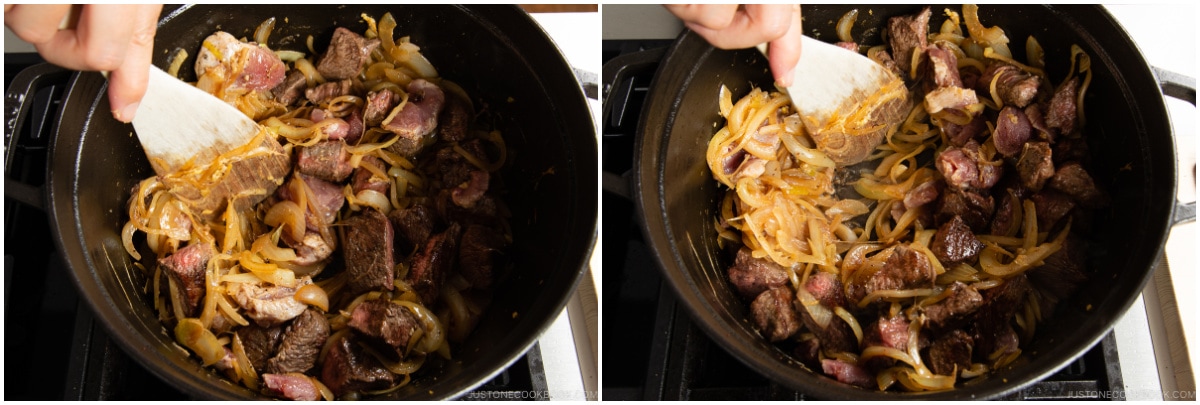
To Simmer the Ingredients
- Next, add 2 cups beef stock/broth.
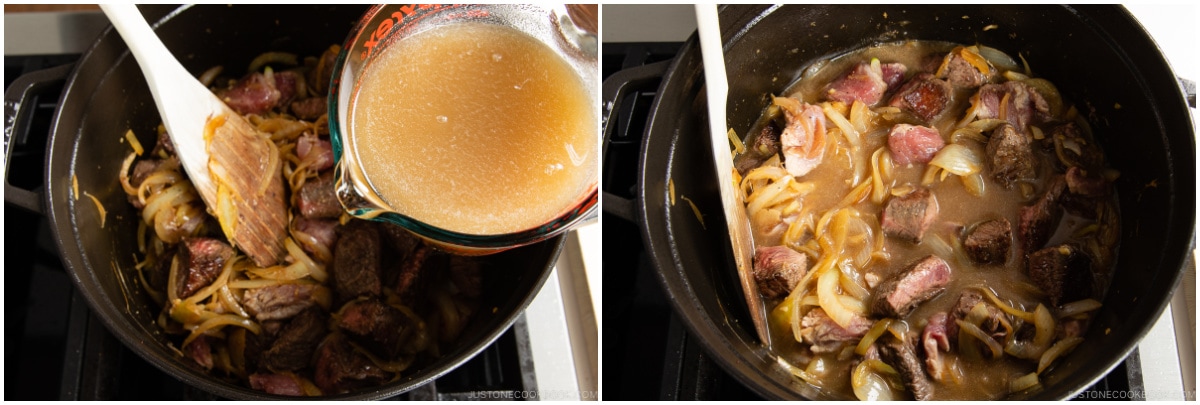
- Add 2 cups reserved tomato blanching water to the pot.
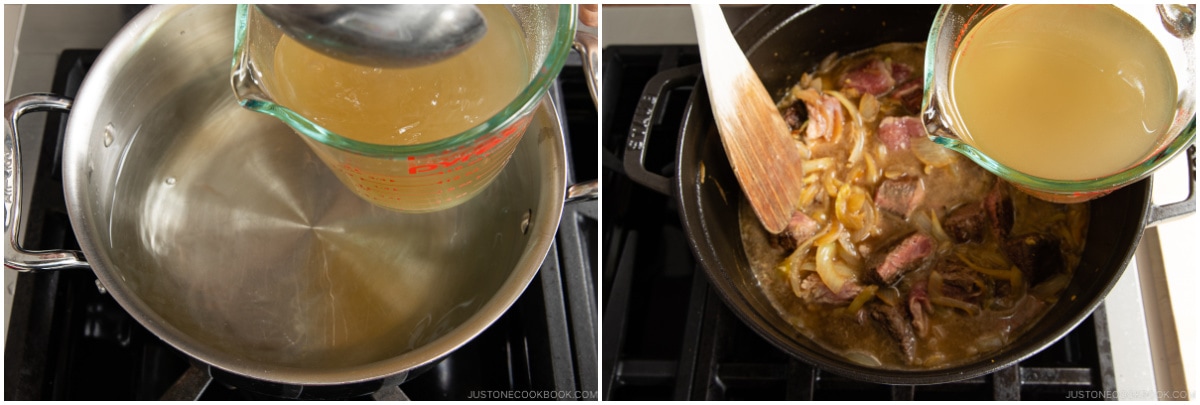
- Add the tomatoes and carrots. (If you are using Yukon gold potatoes, you can add them now. Otherwise, don‘t add the russet potatoes yet.) The cooking liquid should just cover the ingredients; if it doesn’t, add some of the tomato blanching water to the pot.
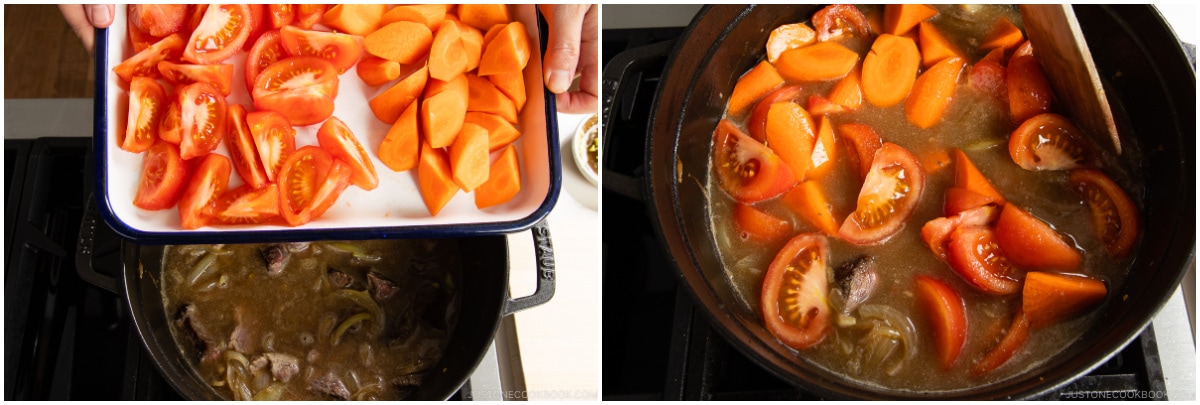
- Cover the pot with a tight-fitting lid and bring it to a boil. Tip: Compared to Le Creuset, I think Staub has a great seal on the lid and prevents evaporation.
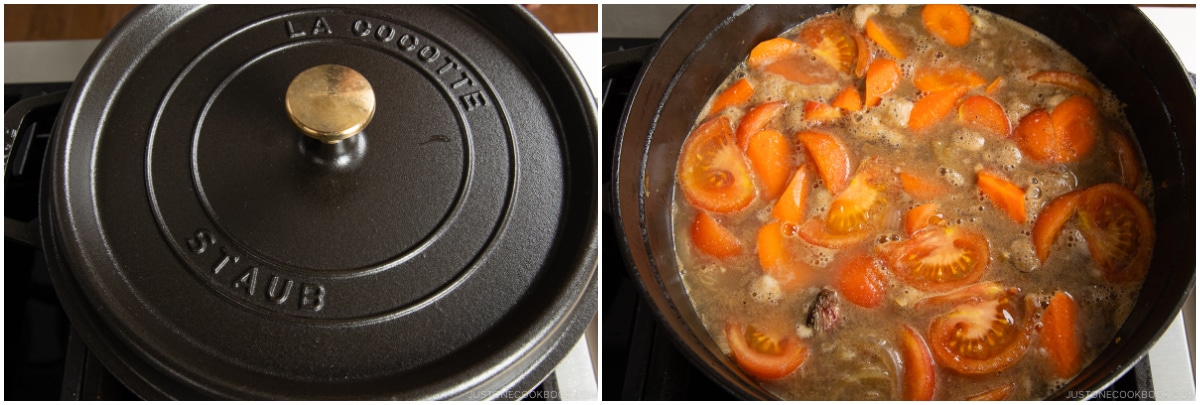
- Once boiling, skim off the scum and fat from the broth using a fine-mesh skimmer. Tip: I add water to my 2-cup measuring cup and rinse my fine-mesh skimmer in it as I go. It’s easy to remove the scum/fat from the skimmer this way.
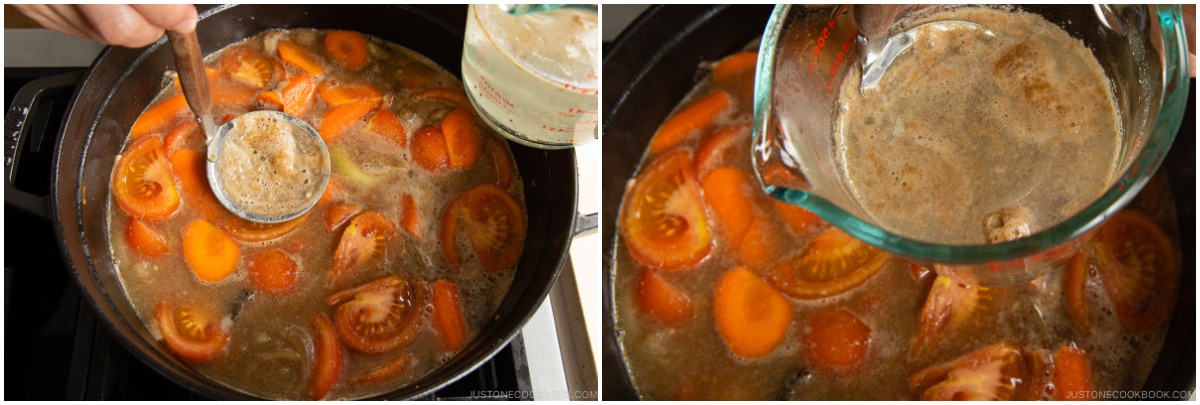
- Add 1 Tbsp soy sauce and cover the pot with the lid. Simmer on low heat, stirring the pot occasionally, until the meat is tender to your liking. This may take 1 hour or longer, depending on the size of the pieces and the cut of beef. Tip: While the meat might be ready after about an hour of cooking, it typically takes 2 hours of simmering for fork tender beef. Tip: If the cooking liquid has evaporated, you may need to add more beef stock or tomato blanching water, enough to just cover the ingredients.
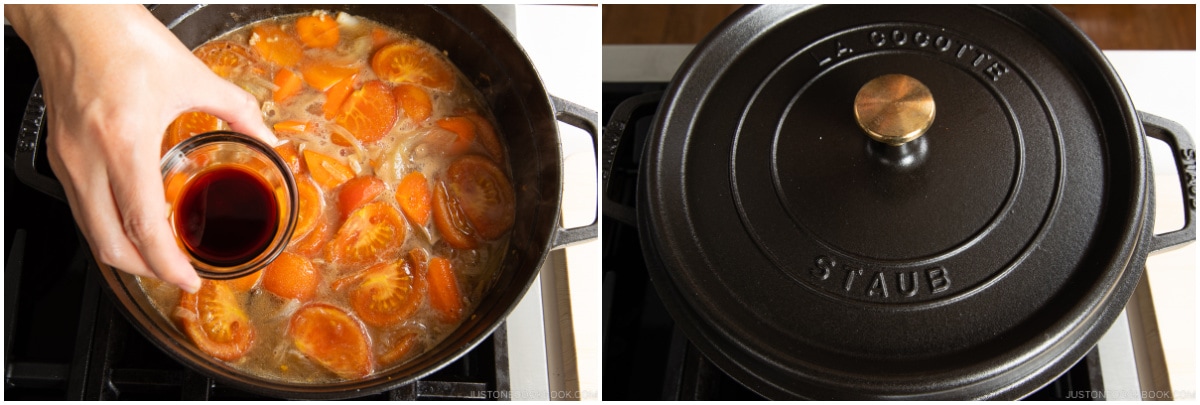
- When the beef is tender, add the russet potatoes, close the lid, and simmer for an additional 15 minutes until the potatoes are cooked through.
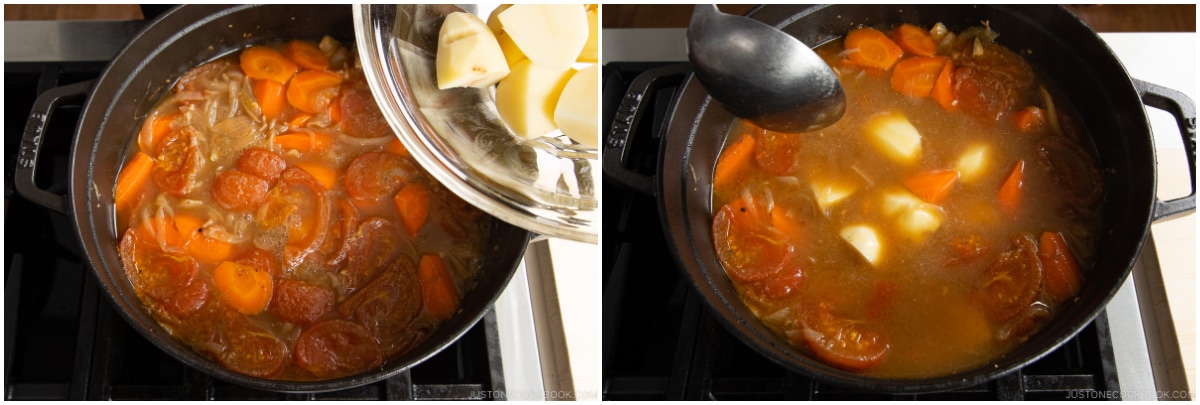
- When the potatoes are tender (check by piercing one with a wooden skewer), turn off the heat.
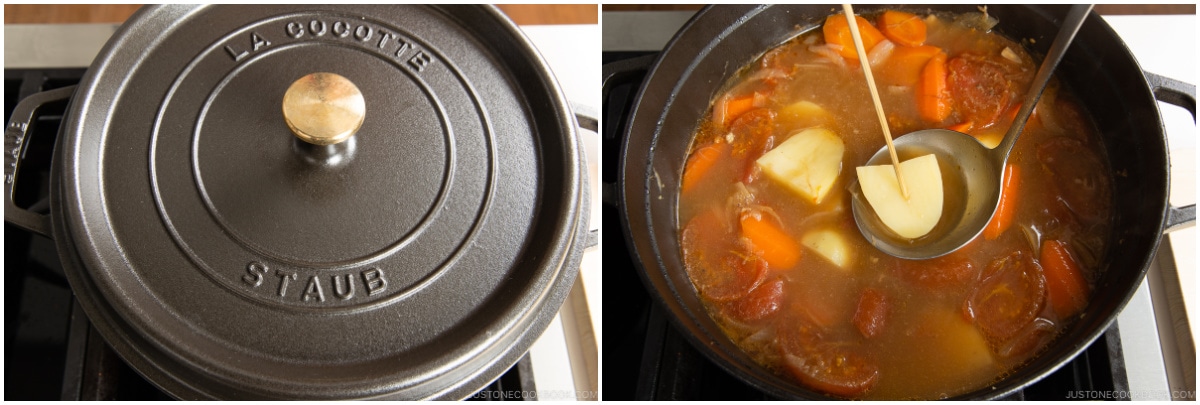
To Add the Curry Roux
- Put 1–2 cubes of the 1 box Japanese curry roux in a ladleful of cooking liquid, slowly let it dissolve with a spoon or chopsticks, and stir it into the broth to incorporate. Repeat with the rest of the blocks, 2 cubes at a time. Adjust the amount of curry sauce roux to your taste. You may not need to use all the roux; reserve the extra cubes for another use. After adding the curry roux, simmer on the lowest heat, stirring often, for 3–5 minutes until the sauce thickens. Be careful not to burn the curry sauce! If it‘s too thick, add more tomato blanching water to dilute. If the sauce is too thin and soupy, uncover the pot and simmer a bit longer to reduce the liquid.
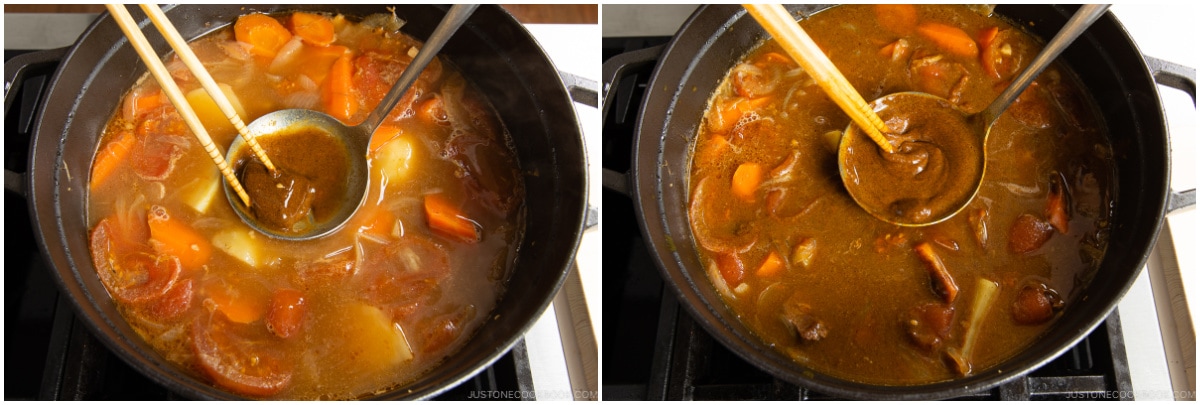
- If you‘re using my homemade Japanese Curry Roux, which is unsalted, season the curry sauce with an additional 2–4 tsp Diamond Crystal kosher salt, to taste.
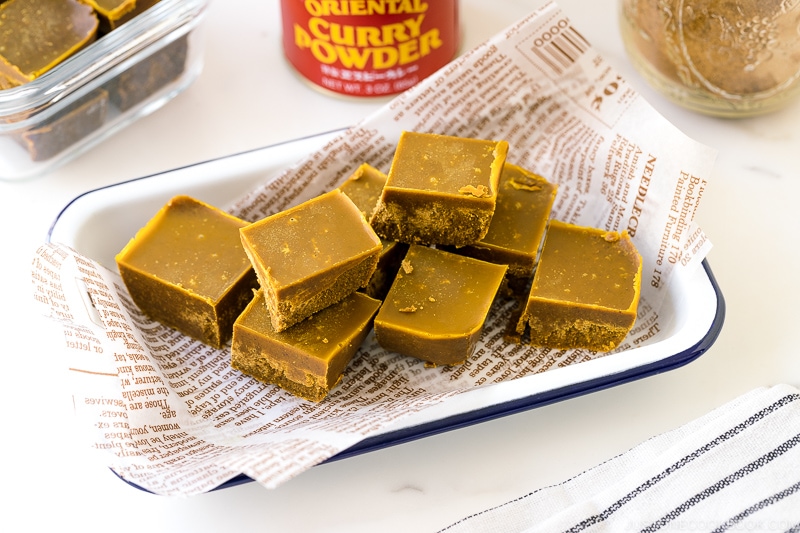
To Serve
- Serve the Tomato Curry hot on individual plates or shallow bowls alongside Japanese steamed rice and top with fukujinzuke (Japanese red pickled vegetables). In the Netflix drama The Makanai, Kiyo serves tomato curry with suage vegetables (eggplant and shishito peppers). You can deep-fry vegetables of your choice following my Sapporo Soup Curry recipe and served on top of tomato curry.
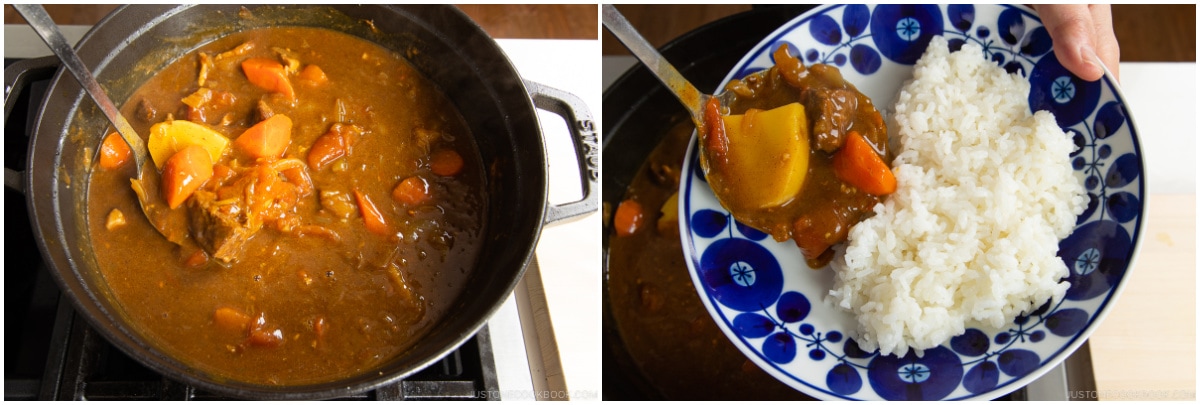
To Store
- Keep the leftovers in an airtight glass container and store it in the refrigerator for up to 3 days or in the freezer for a month. The texture of the potatoes will change in the freezer, so remove them before freezing. Defrost the frozen curry in the refrigerator for 24 hours before you want to reheat it. If you have any leftover unused curry roux, keep in an airtight container and store in the refrigerator or freezer for 1–3 months.
To Reheat
- Leftover curry sauce will thicken into a paste as it cools, so it tends to burn while reheating. To avoid this, stir ½ cup (120 ml) water or more into the leftover sauce until loosened. Then, gently reheat it on low heat. If the sauce seems thin, continue heating with the lid off to reduce the sauce.
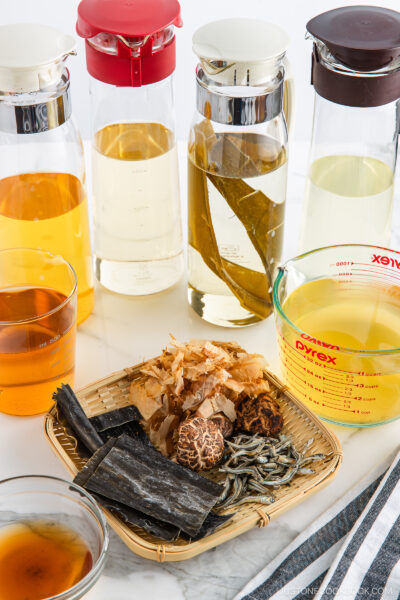
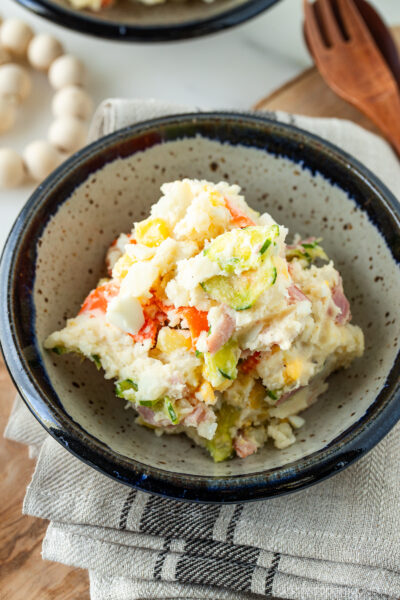
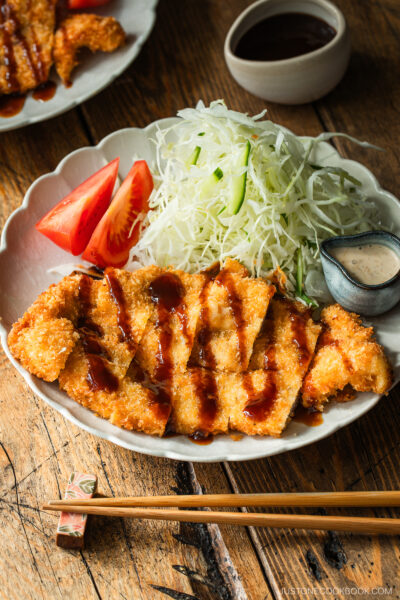
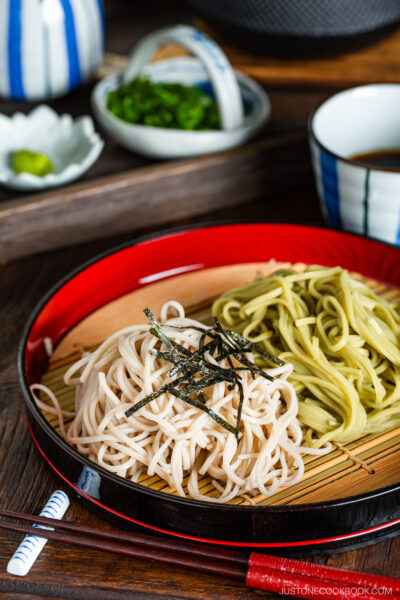




I was about to make this but i realized i dont have curry roux!! can i use hayashi blocks as replacement?
Update: I made this + also swapped out beef for chicken and it was delicious! Added a bit of sweetener and ketchup to round it out ~
Hello, Annie! Thank you so much for taking the time to read Nami’s post and try her recipe!
Hayashi curry roux has a different flavor, but we’re delighted you were able to modify it to your liking.
Thank you for sharing your culinary expertise with us.🙂
Dear Annie,
if in urgent need for curry roux I use Garam Masala and English Curry with kubenen pepper (normal black one is okay too, I just love this one because it’s milder and got more aroma) and salt. In fact I always skip the curry roux and add 1 Tablespoon Soy Sauce and 1 Tablespoon good quality (means traditionally made and not Water and Sugar mixed) Mirin to the cooking water. When everything is cooked through I add the spices and salt, let it cook for about 1-2min (because some curry are not meant to be eaten raw I discovered the bad way), then I thicken it with potato starch. I really like it and it suits me because mostly I’m too lazy to think ahead about what to eat and just want to make it fast and delicious.
Oops I posted the wrong picture. Here’s the picture of the curry!
Hi Christen! Thank you for trying Nami’s recipe and sharing the curry photo with us! Happy Cooking!
My mom always made Japanese curry growing up, but we’ve never put more effort into it than simply chopping up leftover vegetables and throwing the curry cubes in. The added step of adding blanched tomatoes gave a bright twist to a familiar dish. My younger brother and I filmed the whole process for fun, and we fed our friends after!
Hi Christen! Thank you so much for reading Nami’s post and trying her recipe.
We are so happy to hear your family had fun cooking. Thank you for sharing the photo!
Made a vegan version of it with veggie katsu it was amazing, never used tomatoe in my curry before and I’m going to do it more often from now on because it turned to be so good. Thank you fir the recipe!
Hi Berengere! We are so happy to hear you enjoyed the Tomato flavor in your curry!
Thank you very much for sharing your vegan curry picture. That looks amazing! Happy Cooking!
Made this with pork only but still turned out amazing! Tomatoes in the curry added such an umami flavour! Not a complicated recipe either – will definitely do this again!
Hi Kai! Thank you so much for trying Nami’s recipe and sharing your curry photo with us!
We are so happy to hear you enjoyed the Tomato in the curry! Your curry photo looks so delicious!
This was such a nourishing meal! I made a vegetarian version and used a spoonful of vegetarian bouillon to add some extra umami flavor. Can’t wait to try this recipe again using JOC’s homemade curry roux recipe! Thanks so much for the recipe!
Hello, huagraphie! Thank you for trying Nami’s recipe!
Your curry looks amazing! Yes! We hope you’ll try Nami’s homemade curry roux recipe as well. We hope you like it!
Had a great time making this recipe! I really like how the tomatoes complimented the curry flavor!
Hi Synneva! Aww. We are so happy to hear you enjoyed the curry flavor!
Thank you so much for trying Nami’s recipe and for your kind feedback.
Made this using some leftover sirloin roast I had. Came out super good – the tomatoes added a savory -sweet acidity that melts in the mouth. I gotta try making this again!
Hi DDCD! Thank you so much for trying Nami’s recipe and sharing your Curry photo with us! It looks so perfect!
We are so happy to hear you enjoyed the curry!🥰
I decided to try making this when I saw the Makenai recipe post since I’ve been wanting to try making a Japanese curry for awhile – I’ve made many North India ones but never a Japanese one.
The recipe came out perfect, and the taste of Japanese Curry is different but also equally delicious. I had it once in Japan but it was back in 2002 so I had forgotten what the difference in taste was. This brought the happy memories back!
I had bad lighting in my kitchen but I took a photo anyway~
Hi Heather! Thank you so much for trying Nami’s recipe and sharing your curry photo!
It looks delicious! We are glad to hear you enjoy it. Happy Cooking!
Thank you so much for this recipe! It was really yummy and the tomatoes made the curry sweeter. Yoko Kanno’s “Minarai” kept playing in my head while I was making this 😆
Hi Shar! Thank you for trying Nami’s recipe and sharing your curry photo!
Yes! The music “Minarai” is playing in our heads as well! 😁 It is so beautiful!
I’ve always made the JOC instant pot version but Makanai Netflix series inspired me to cook slower and the addition of tomatoes made it delicious! #JOCcookingchallenge
Hi Koto! Thank you so much for sharing your curry photo! It looks so delicious! 🤩
Love this recipe! The tomato flavor was so rich and it gave a good balance to the flavor of the curry. Think this is going to be our go-to curry recipe.
Hi Jackie! Thank you so much for your kind feedback!
We are so happy to hear you enjoyed the recipe. Thank you for including Nami’s curry dish among your favorites!
I tried my best to make my version without meat and used eggplant as a substitute. It went rather well if I do way so my self. I will be having curry for the next two weeks, as I made over 3 liters of it. But you gotta do what you gotta do when you are a poor student. I accidentally burned my onions so I had to rinse the pot in the process.
I even made the roux from scratch using your recipe!
Hello, Terry! Thank you very much for experimenting with Nami’s recipes.
Nami and everyone at JOC are happy to hear you enjoy the curry and to see your curry photo!☺️
Thank you for taking the time to tell us about your culinary adventures.
This curry was delicious! I liked how the tomatoes helped to cut the richness of the curry. I followed Nami’s advice and bought beef chuck (blade roast in Canada) and it was tasty. I used yellow potatoes and added them in 30 mins later as I didn’t want them too soft. The beef was tender in an hour but some of the pork tenderloin was falling apart so I’ll cut the pork slightly thicker next time. Can’t wait to make it again!
Hi KY! Thank you so much for trying Nami’s recipe and sharing your experience and curry photo!
It looks so delicious!
This Netflix series warmed my heart. This recipe will warm my stomach. Although I’ve been eating Japanese curry for many, many years, I’ve never made it with tomatoes.
Thanks for the recipe.
Hi bkhuna! Hope you enjoy this recipe! It’s not tomato forward dish (like very tomato-y), but my kids and Mr. JOC noticed the difference and they absolutely loved this curry. Hope you do too!